North America is home to a wide range of black and white butterflies of all sizes.
Most butterflies with black and white coloring are found in Western and Southern US territories. A good range of black and white butterflies are also found in the Northern territories.
These types of butterflies live at different altitudes from valleys to sunny mountain slopes.
Most feed on various types of flower nectar and lay eggs directly on flowers.
Black and white wing colors come in different patterns. Some butterflies can appear mostly white while others are mostly black.
The colors of these species do not determine their feeding habits, mating habits, or general behavior. Some of the similar black and white butterflies can be distinguished by the flowers they feed on since many only feed on a specific flower.
The following species are most representative of black and white butterflies in North America.
Table of Contents
1. Cabbage White
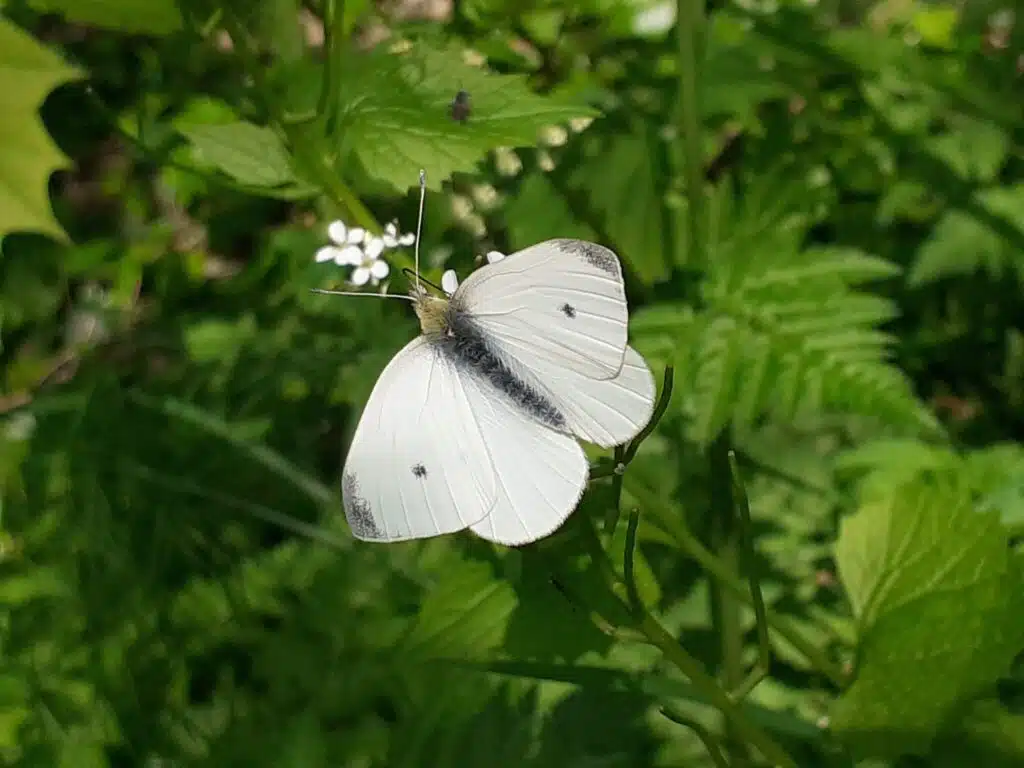
The Cabbage White butterfly (Pieris rapae) is one of the most common black and white species in the world.
It’s native to North America and Europe and it represents a species that’s adapted to living both in urban settlements and outside them, particularly in long valleys.
The species has white wings and black spots on the forewings.
Females tend to have an off-white color, closer to cream. Males have pure white wings.
As its name implies, Cabbage White butterflies are a pest on cabbage crops. They also invade other crucifers such as broccoli.
2. Summer Azure
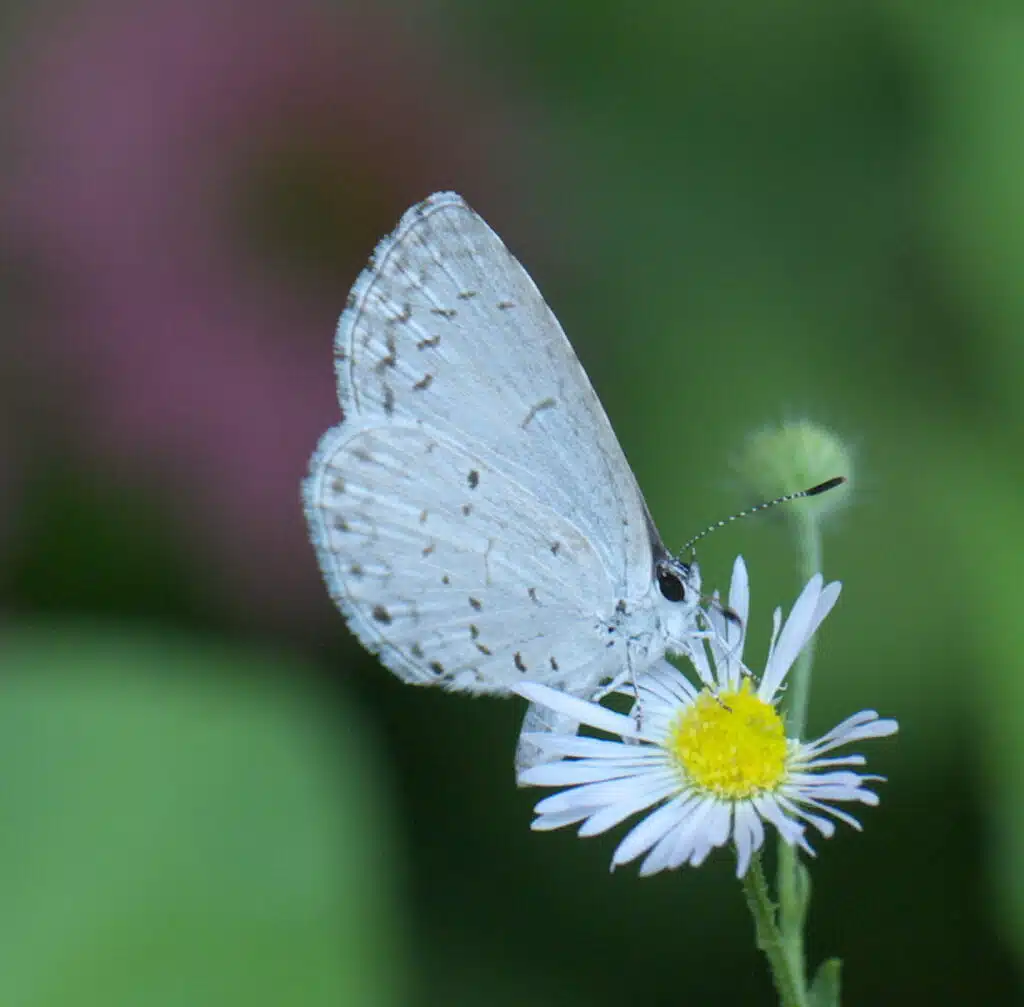
The Summer Azure (Celastrina neglecta) is known for its blue color in females. However, male Summer Azure butterflies are black and white.
Even some female Summer Azure butterflies have a black and white body as the blue color of the wings seems to be diminishing in many Eastern and Central parts of the US.
The species is also found in Canada where it flies starting from June.
Summer Azure butterflies come in varying sizes, depending on their environment.
They grow to at least 23mm in wingspan with the largest Summer Azures having up to 29mm wingspan.
3. Common Checkered-Skipper
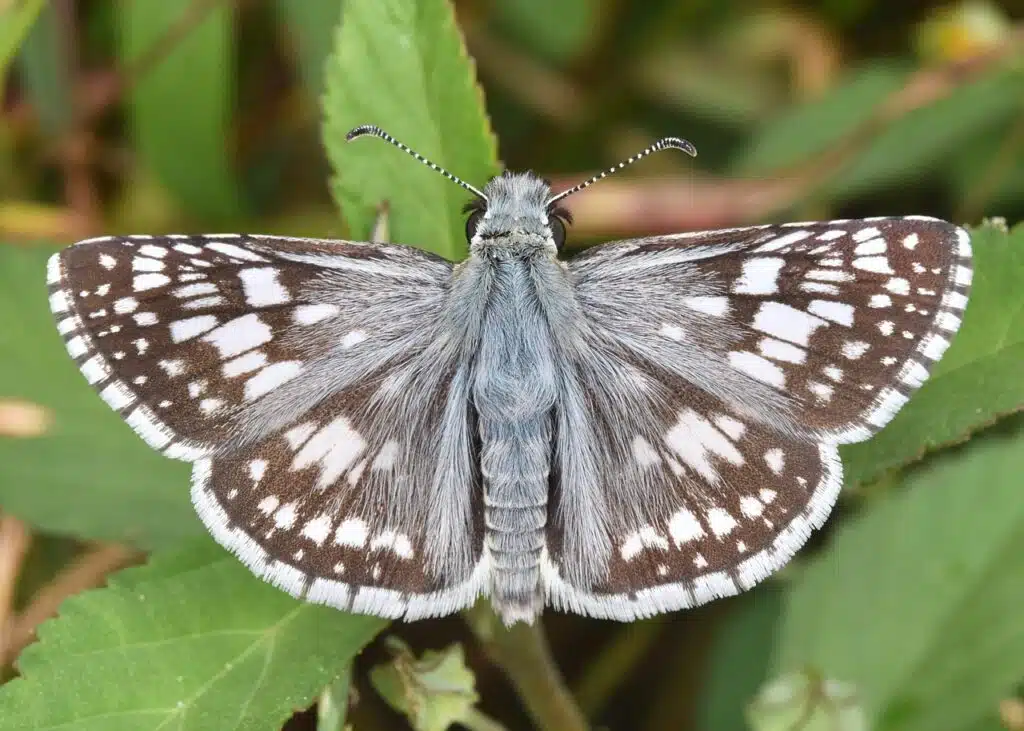
The Common Checkered-Skipper (Burnsius communis) is a species of black and white butterfly with a checkered black pattern.
Small differences exist between the coloring of the male and the female, as with many butterflies.
Males have more prominent checkered patterns.
Butterflies of the Common Checkered-Skipper genus have a large distribution. They are found all across the US and further in Southern Canada.
Butterflies of the species are common in Central America as well. Their territory expands into Northwestern Southern America to countries such as Colombia, Ecuador, and Peru.
4. Zebra Swallowtail
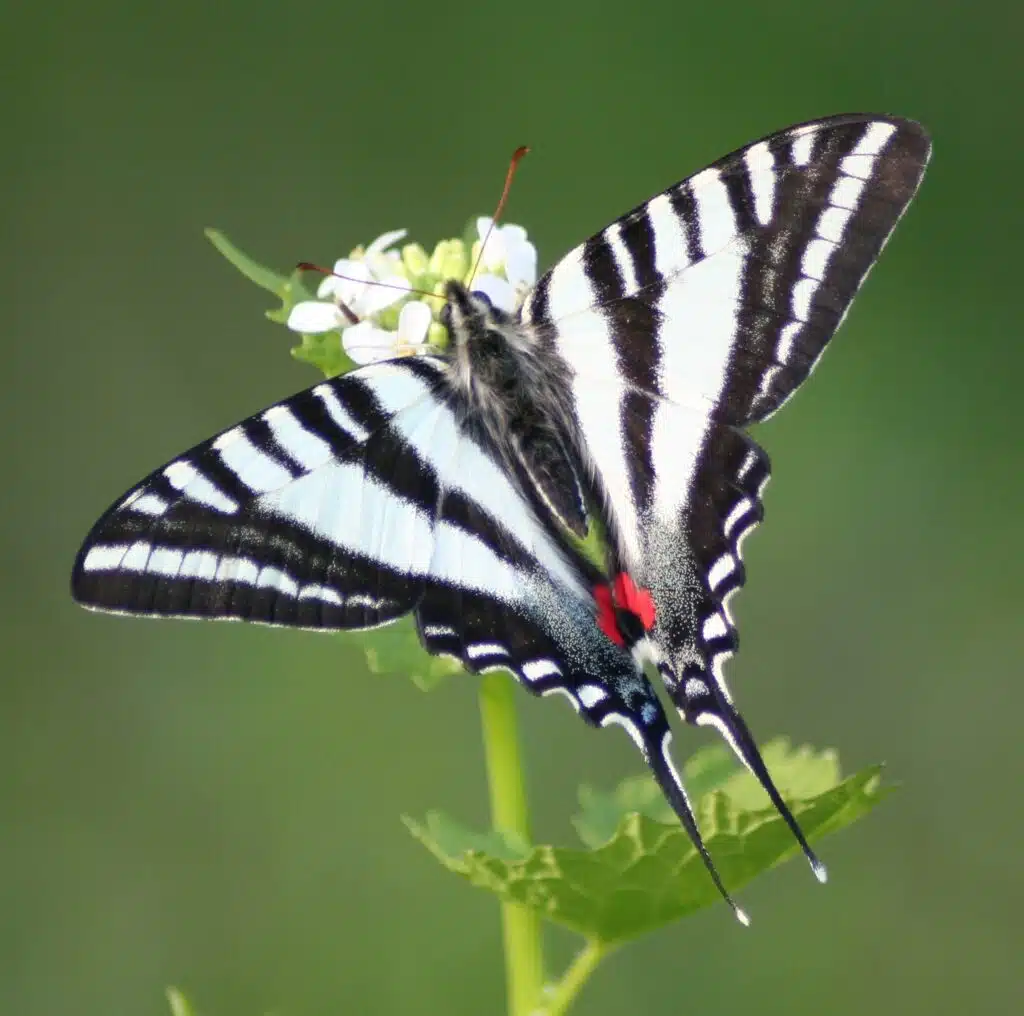
The Zebra Swallowtail (Eurytides marcellus) is a species of black and white butterfly with long tails.
As their name suggests, these butterflies are mostly black and white. They have triangular-shaped wings which show alternating black and white strips.
The species is common in Southeastern US states, including Florida.
Males can be seen looking for females twice per year, as their new generations emerge.
Both males and females are known for living and feeding on various flowers specific to the Southeast. Dogbane is the favorite flower of Zebra Swallowtails.
Zebra Swallowtails are also known for eating other foods apart from nectar and pollen. They often feed on various fruits.
5. Zebra Longwing
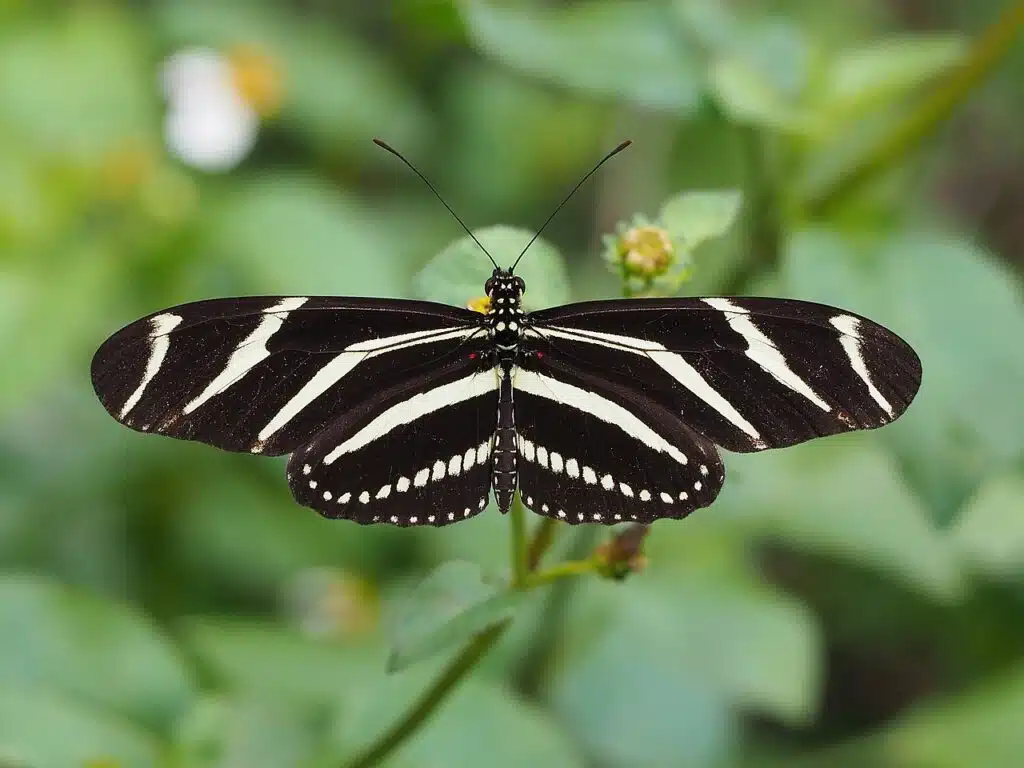
The Zebra Longwing (Heliconius charithonia) is another black and white species. Highly similar to Zebra Swallowtails, Zebra Longwing butterflies have wider black and white alternating stripes on their bodies.
These butterflies immediately stand out in their natural habitat. They are known for feeding on passionflowers found in the US.
Butterflies of this genus consume both nectar and pollen and survive up to 3 months in the wild or even more when bred in captivity.
Zebra Longwings are among the few black and white butterflies that maintain their colors similar to the caterpillar which is mostly white with black spots.
Butterflies of this genus live in groups. Up to 60 Zebra Longwings can be seen together at night since living communally decreases the risk of individual-level predation.
6. Lorquin’s Admiral
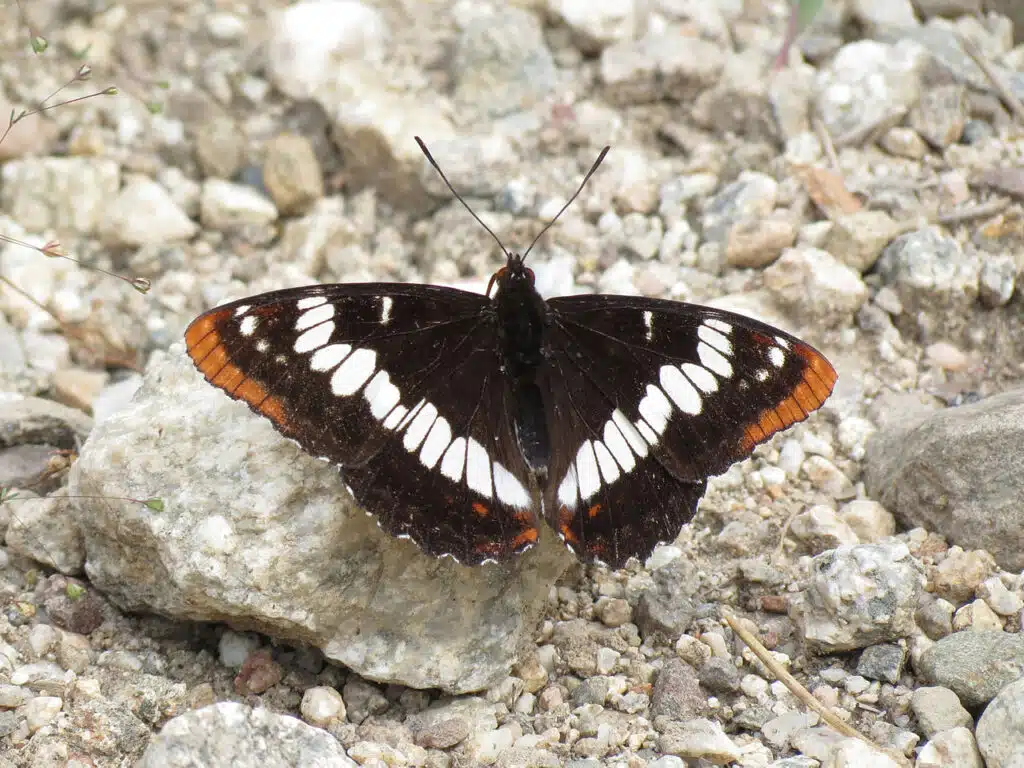
Lorquin’s Admiral (Limenitis lorquini) is a type of butterfly found at high altitudes. This species is found around forest edges at elevations of up to 4.500 feet.
It was during the Gold Rush that the remote areas this species lives in made its discovery possible.
The butterfly is mostly black with white marks across the central area of its wings and orange spots on the sides of the wings.
Butterflies and larvae of the species are particularly known for eating and nesting in hardwood trees. They are seen on poplar and willow.
Lorquin’s admirals are some of the most aggressive black and white butterflies. They are known to pounce on many types of intruders which is not necessarily another species of butterflies.
They can pounce on birds to drive them out of their range.
7. Spicebush Swallowtail
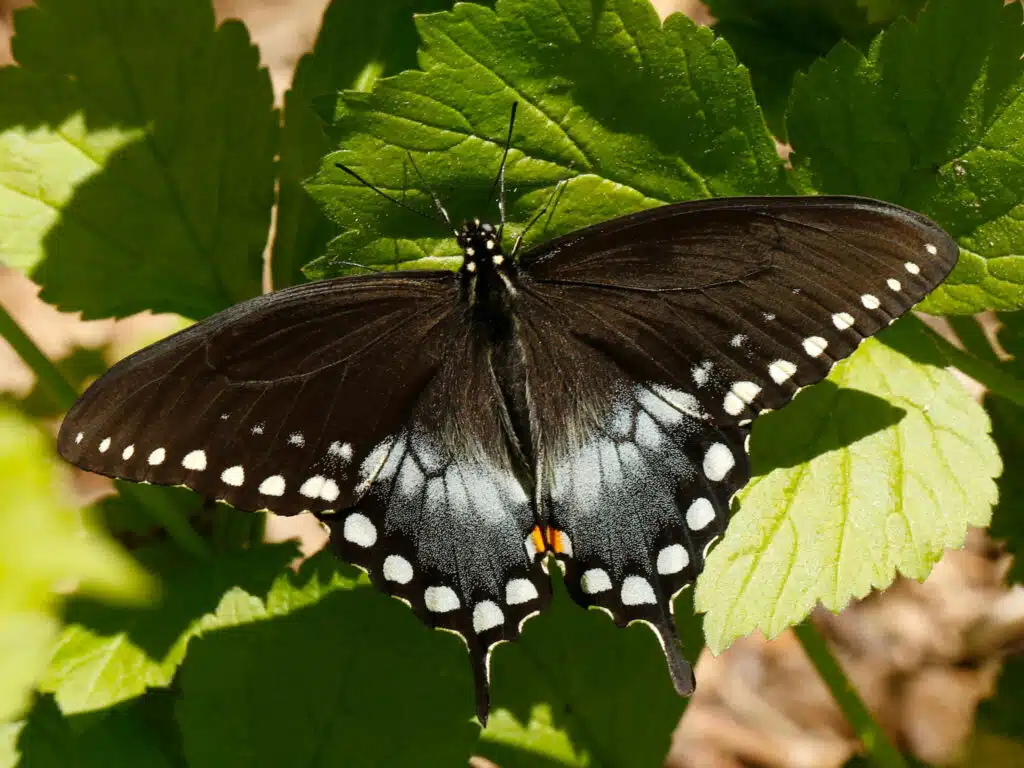
The black and white Spicebush Swallowtail (Papilio troilus) is known for its love of spicebush. This species is also known for drinking nectar from honeysuckle and Joe-Pyes.
Butterflies of this species are almost completely black. White marks can be distinguished on the sides of its wings, together with pale blue marks.
This genus is common in Southeastern US territories where they live in forests and swamps.
Small differences in habitat have been noted between the genders of the Spicebush Swallowtails.
Males wander off in swamp areas for high humidity and the flora they find. Females prefer to stay in open areas next to these woodlands.
8. Pale Swallowtail
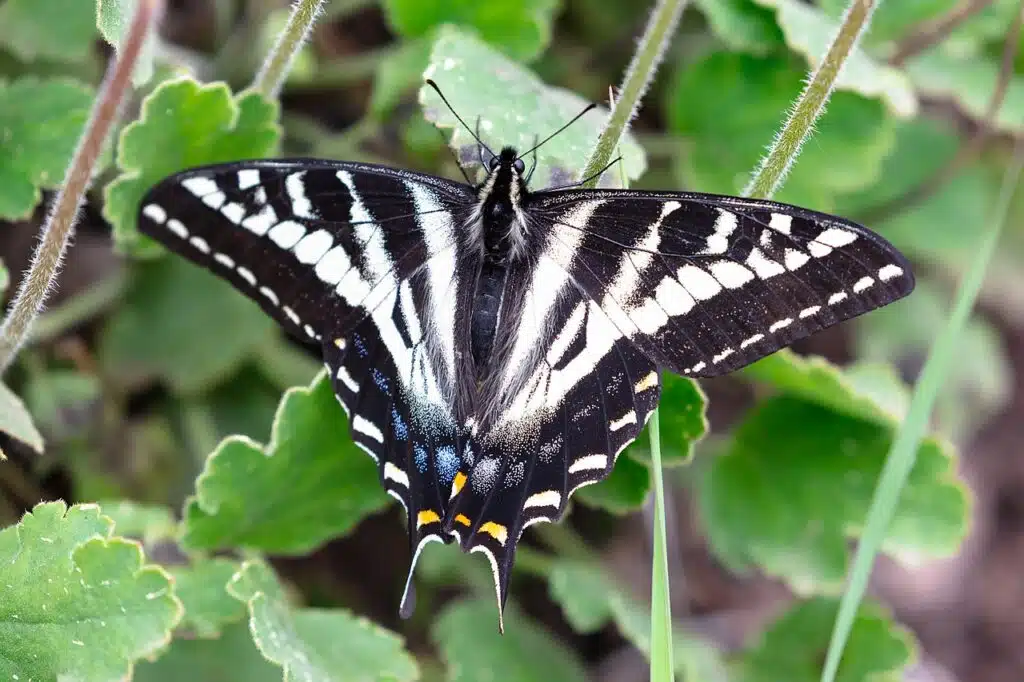
Pale Swallowtails (Papilio eurymedon) are commonly seen in woodlands around California and the West Coast up to Canada.
Butterflies of this species love woodlands with permanent water sources such as lakes.
They often feed on the water of these water sources to gain the nutrients they need. This is a shared process where males drink water together before moving to seek out female partners and mates.
Butterflies of this species are known for having striking contrasting coloring. They are either black and white or cream and white.
The coloring pattern appears as alternating stripes. The stripes are longitudinal or parallel to the body of the species.
Females of this genus lay overwintering eggs on flowers and vegetation. Buckbrush is their favorite host for the eggs.
9. Palamedes Swallowtail
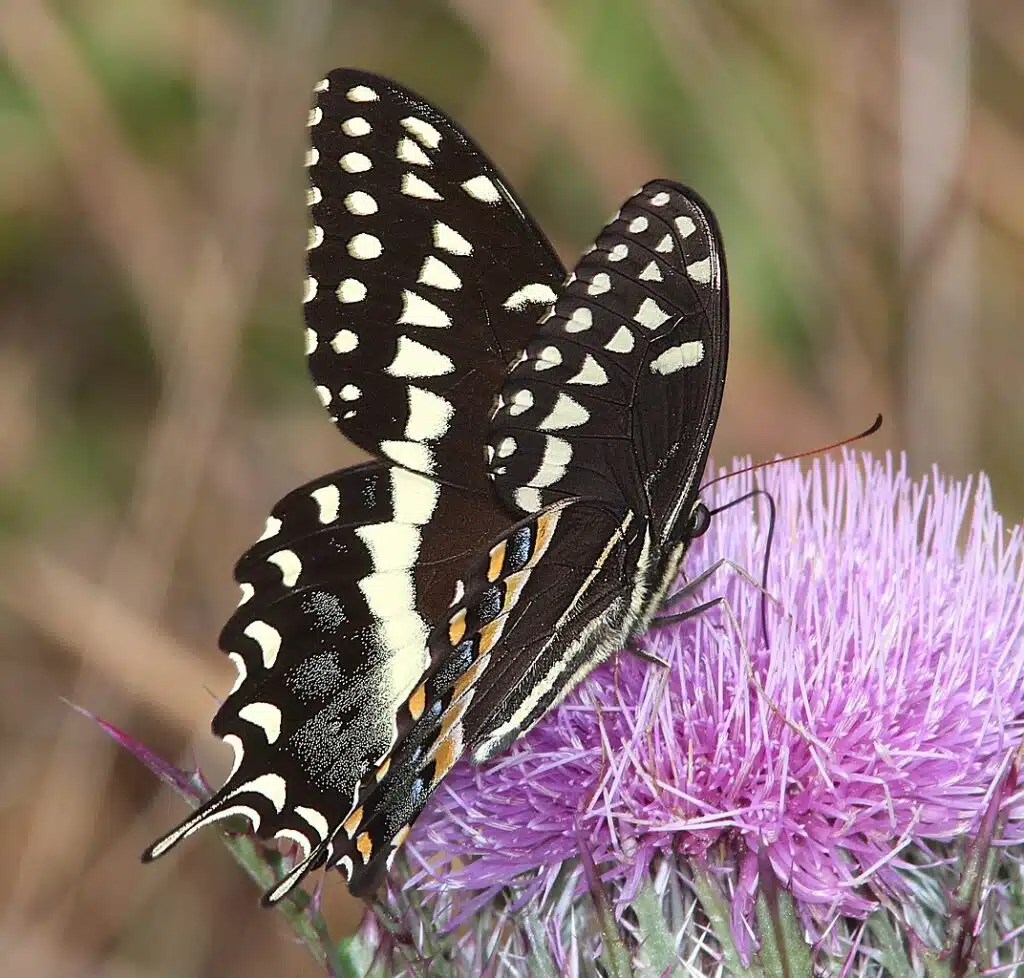
Palamedes Swallowtails (Papilio palamedes) are butterflies found in swamplands of Florida and neighboring states.
This species has black wings, a black body, and white bands and dots on the edges of the wings.
Males and females are only seen together during the mating period when they can fly at a close distance.
Male Palamedes Swallowtail seeks out females which live on the edge of woodlands to mate.
Females lay eggs directly on various plants and flowers.
Redbay is one of the preferred host plants for the female Palamedes Swallowtail to lay eggs on. The plant has thick green leaves that host the eggs.
10. Tropical Checkered-Skipper
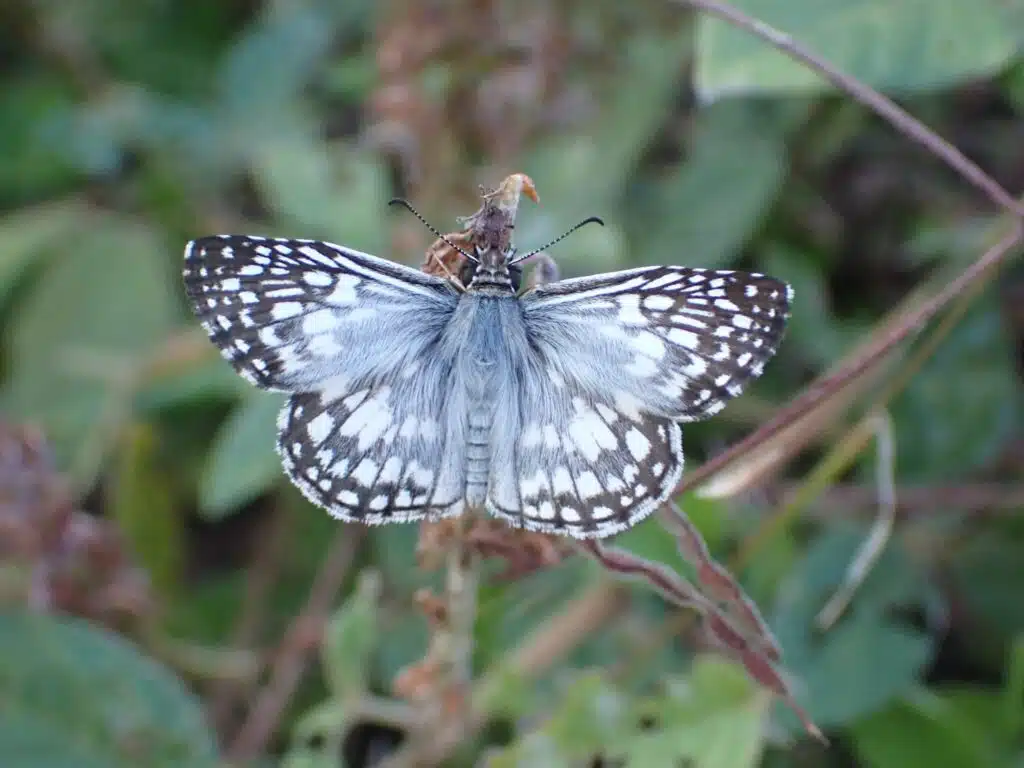
Found across the Gulf Coast, the Tropical Checkered-Skipper (Burnsius oileus) is a native US species.
It has a checkered black and white body which allows for easy species identification.
The butterflies prefer open areas with plenty of sunshine. As a result, they are also abundant in Peninsular Florida.
With a very long flight season in Florida and Texas, this species is known for laying eggs directly on plant leaves.
Adult Tropical Checkered-Skippers feed on various small plants. The nectar they prefer comes from Shepherds’ needles.
11. Mournful Duskywing
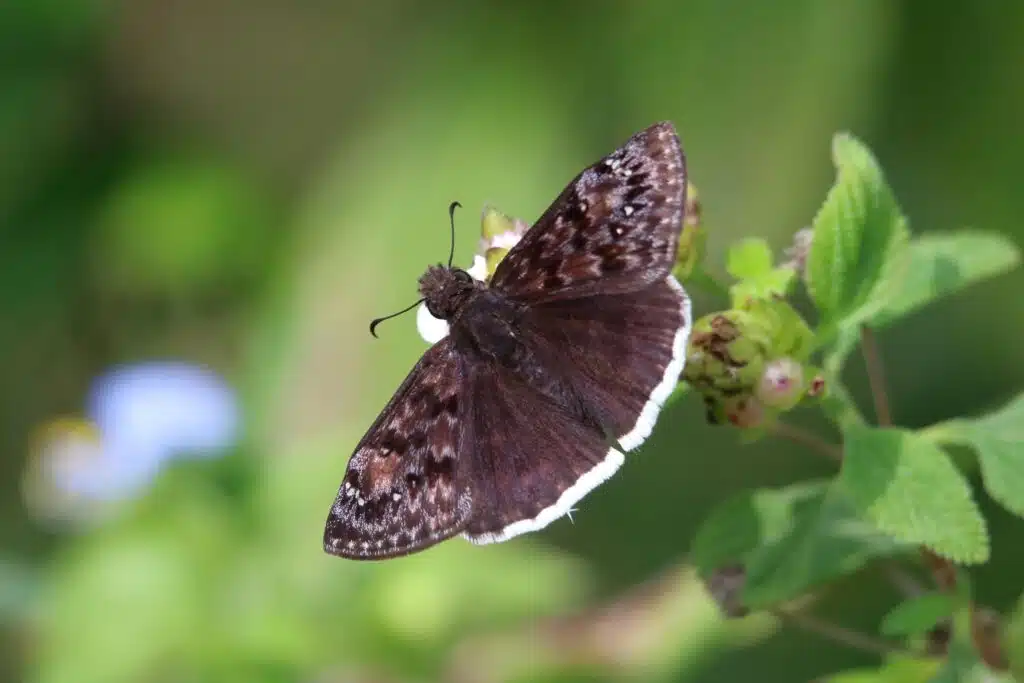
Mournful Duskywing butterflies (Erynnis tristis) have a dark brown or black coloring that dominates the wings with a white band on the edges of the wings.
The species is common in territories across California, New Mexico, and Arizona.
Mournful Duskywing butterflies spend a lot of time looking for a prospective mate. Males are known to look out for females each day.
Butterflies of this genus lay eggs directly on the leaves of various hardwood trees found in Southwestern territories.
Blue oaks are among the favorite hosts for the eggs.
The larvae of the Mournful Duskywing mainly feed on oak leaves as it grows.
12. Margined White
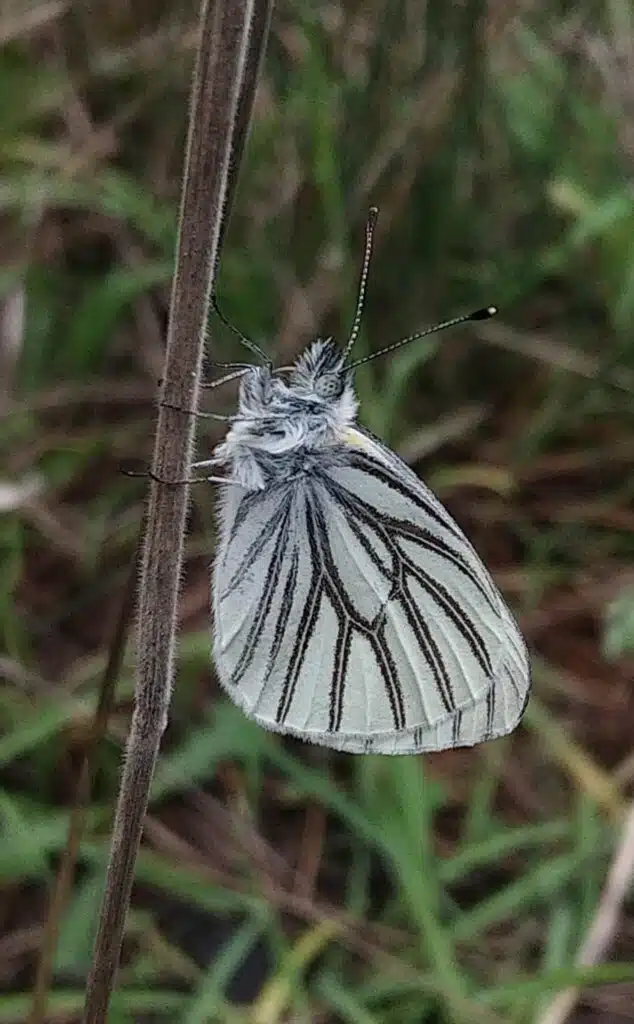
Margined White butterflies (Pieris marginalis) are native to the US. They live in vast Western territories where they prefer prairies, woodlands, and other areas if they get sufficient sun exposure.
The species has dominantly-white wings.
These wings show faded black marks or stripes, depending on the gender. However, both males and females have white wings with black marks across.
Butterflies of this genus don’t have a wide diet as they prefer plants in the mustard genus.
While it stands out to predators, the species is diurnal and inactive at night.
13. Weidemeyer’s Admiral
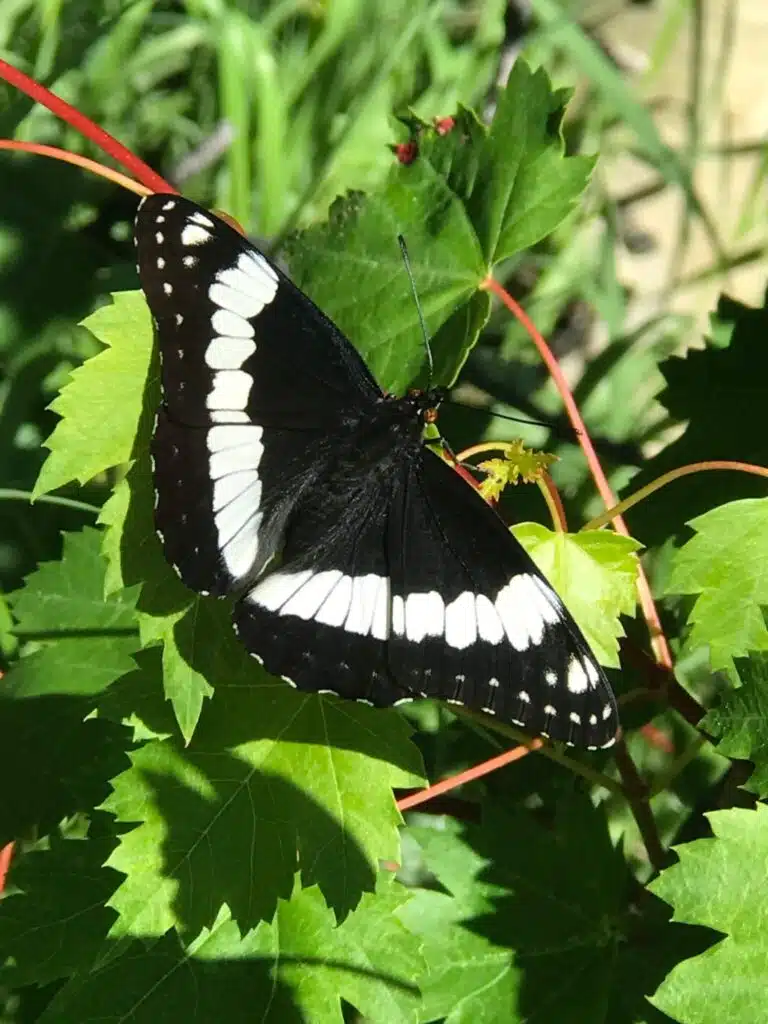
This butterfly species (Limenitis weidemeyerii) is identified by its mostly black wings with white dots towards the edges.
The ventral side of the species is brown.
Weidermeyer’s Admiral butterflies are also known for having a vast diet which includes feeding on carrion.
Some people believe this butterfly eats carrion as a source of protein just before mating.
Butterflies of the genus also feed on plant nectar. They lay eggs on willows and other trees.
Males and females have very different behavior. Females fly from one food source to another.
Most males mostly stay still on trees watching the females all day.
14. Cassius Blue
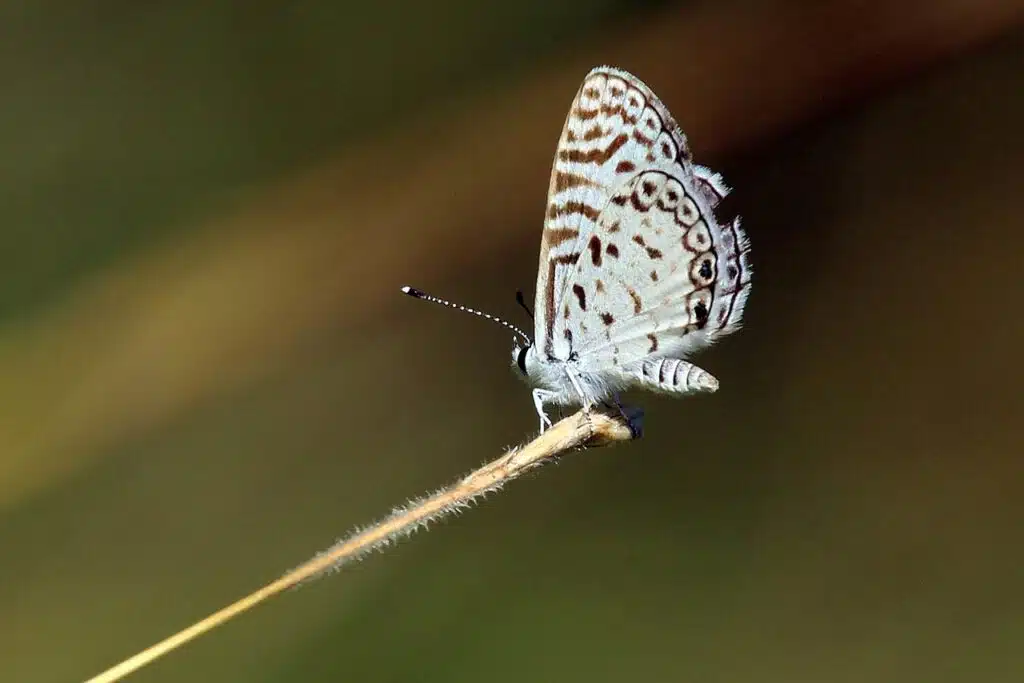
Cassius Blue (Leptotes cassius) is sometimes known as Zebra Blue.
The species combined zebra-specific black and white colors with vivid blue coloring.
Its wings are mostly black on the edges, blue towards the body, and white with black eye-like spots towards the rear.
Butterflies of this genus are very common in Florida.
It’s here that adults can mate and lay eggs on their favorite plants and trees. Plants of the pea genus are particularly favored by Cassius Blue females when it comes to laying eggs.
This species is further known for its impact when it comes to eating these flowers of the pea family.
Cassius Blue larvae feed on these plants as they grow.
15. White Checkered-Skipper
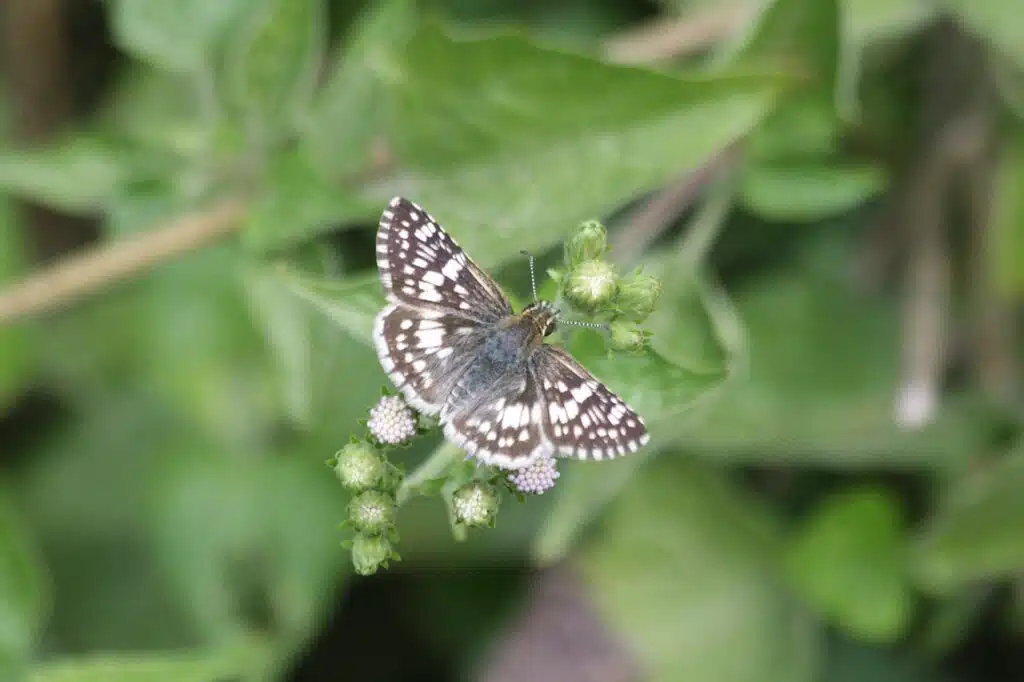
White Checkered-Skippers (Burnsius albescens) is a common species in Southern Texas and other Southern states.
The color of these butterflies is mostly black, with a checkered pattern on the wings.
White spots are common on the species and they can indicate the gender of the butterfly as males have more spots.
The edges of the wings are always white.
Butterflies of this genus like to feed on the nectar of various wildflowers. These are shrub-like flowers that grow in very adverse conditions with not much water.
White Checkered-Skippers prefer to feed on the nectar of mallow flowers.
16. Clodius Parnassian
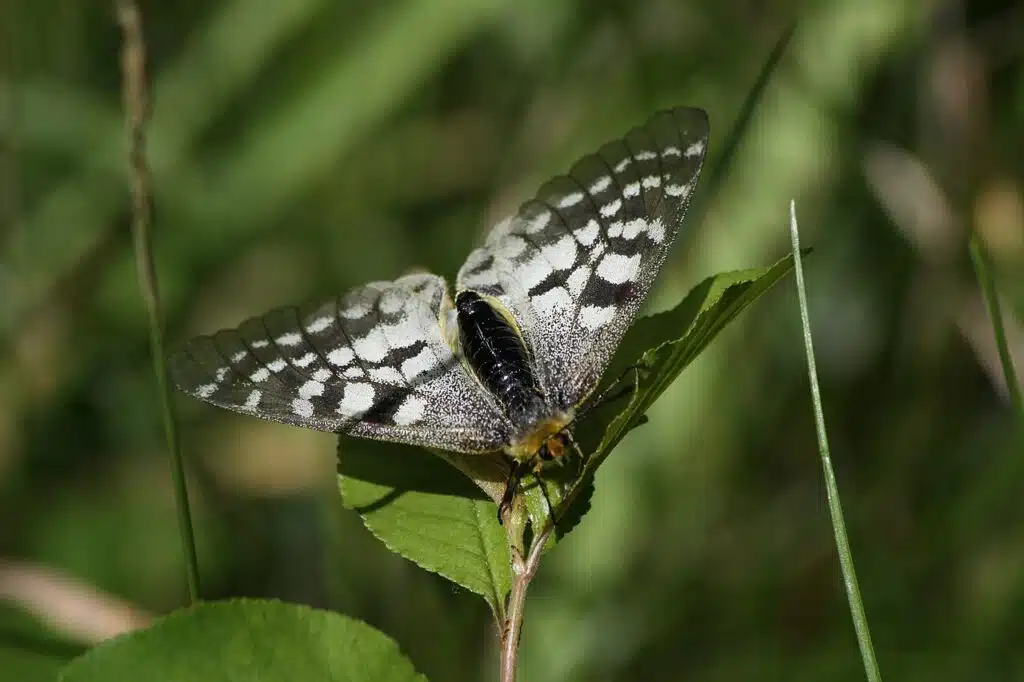
These butterflies (Parnassius clodius) have black and white wings. They might also show red spots on hindwings.
Clodius Parnassian is a common species living at high altitudes West of The Rocky Mountains.
They feed and lay eggs on multiple types of flowers of the Bleeding Heart genus.
Clodius Parnassians have very specific mating behavior. These butterflies prefer to only mate under certain conditions.
Males lay a pouch on the female which prevents further mating with other prospective males.
This behavior is not combined with aggressiveness when it comes to territory control.
Females lay eggs directly on flowers. They can lay a series of eggs on multiple plants at once.
17. Melissa Blue

Melissa Blue butterflies (Plebejus melissa) are mostly found in Western and Central US territories.
Just a few small colonies survive in the Eastern territories.
Melissa Blue butterflies are known for having a pale blue color in the case of males.
Females have white-dominant wings with a few black dots.
Karner blue flowers are among the favorite source of food for these butterflies.
These flowers are often guarded by a male-only allowing a prospective female mate to approach.
Melissa Blue caterpillars don’t grow on Karner blue but rather on lupine groups of plants.
18. Greenish Blue
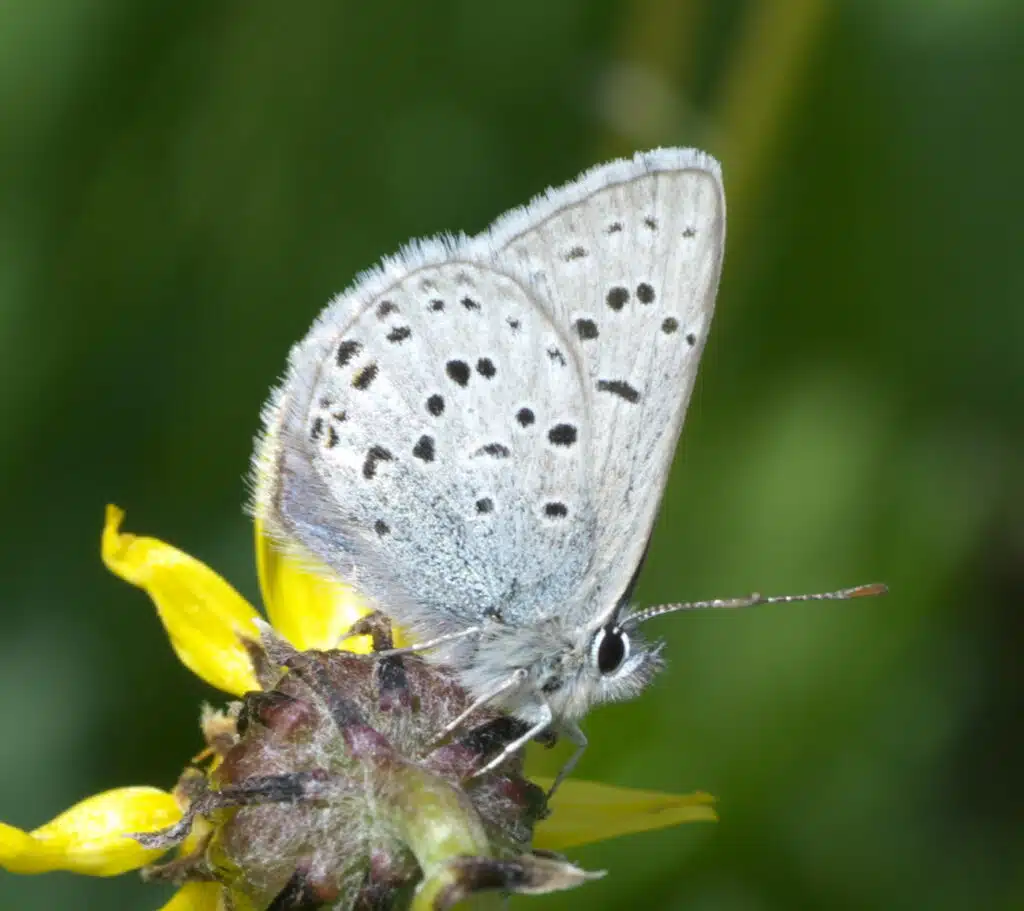
Greenish Blue butterflies (Icaricia saepiolus) have a blue, black, and white color.
Females have a white-dominant color with small black dots.
The species live at very high altitudes up in the mountains. It’s mostly found in Northwestern territories.
Greenish Blue butterflies have a very short flight season given they aren’t found down in valleys.
They appear in June and they only survive up until August.
19. Bernardino Blue

Bernardino Blue butterflies (Euphilotes bernardino) are one of the multiple black and white species that are facing a diminishing habitat.
Common in California, this species now faces a narrow habitat given urban development is increasing at a higher rate.
Males of this species are mostly blue but females have white wings with black spots and a wide orange band next to the edges of the wings.
Butterflies of this genus are highly territorial.
Males spend a lot of time defending their territory around the flowers females feed on.
Bernardino Blue caterpillars grow directly on plants they feed on. They produce a sticky sweet substance that attracts ants.
In turn, ants are known to deter many types of predators ensuring butterflies can emerge without too many predators.
20. Lupine Blue
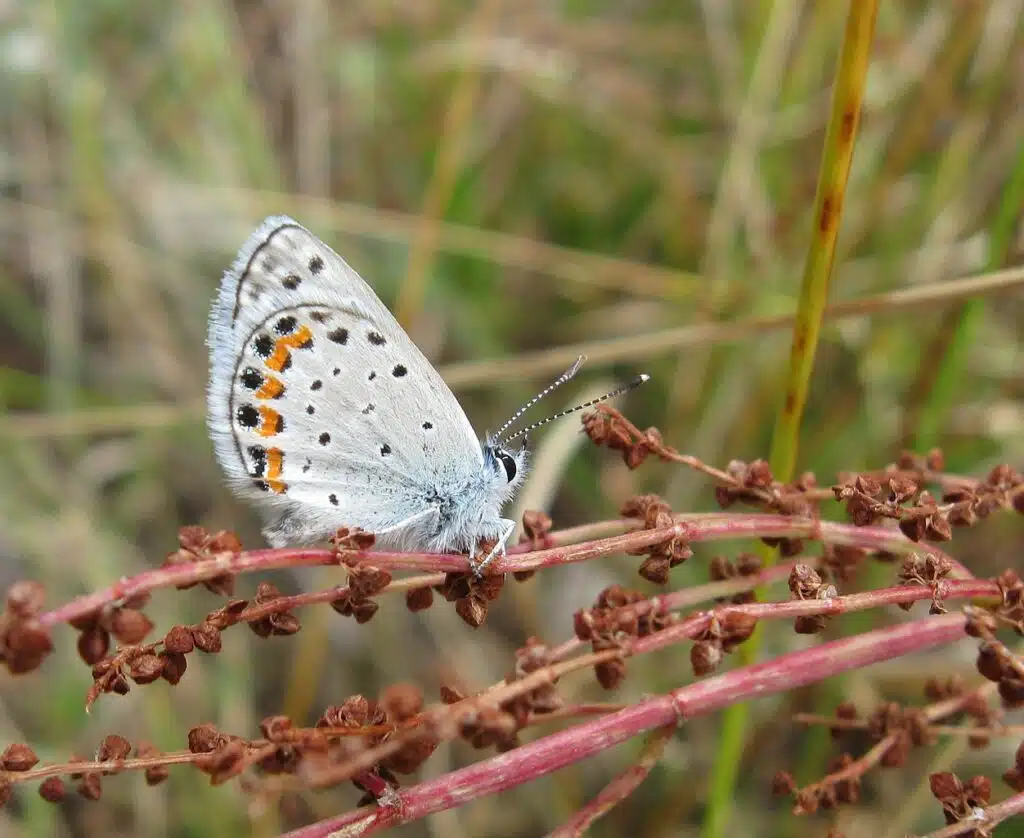
Lupine Blue butterflies (Icaricia lupini) are a known species around lupine flowers.
The male is mostly light blue while the female has white wings with black and orange dots. The orange dots are wider than the black dots, similar to many white-dominant female butterfly species in the US.
With a wingspan of over 30mm, the species is mostly seen in California.
The warm weather in the state allows for a long flight season.
Lupine Blue butterflies can emerge early as soon as March arrives.
Feeding on plant nectar, these butterflies don’t survive until the end of the summer as their flight season ends in July.
21. Western Tailed-Blue

The underside of the Western Tailed-Blue butterfly (Cupido amyntula) is mostly white. It shows just a few small black spots.
Dorsally, this species has a blue color with black marks.
When its wings are close, the species appears white and it tends to blend in with the flowers it visits.
Western Tailed-Blue butterflies mostly visit white flowers followed by pink flowers.
The caterpillars of the Western Tailed-Blue don’t resemble adults in coloring.
They are mostly brown which means they do not resemble either adult males or adult females in coloring as they undergo a complete metamorphosis in terms of color when they emerge as adults.
22. Laviana White-Skipper
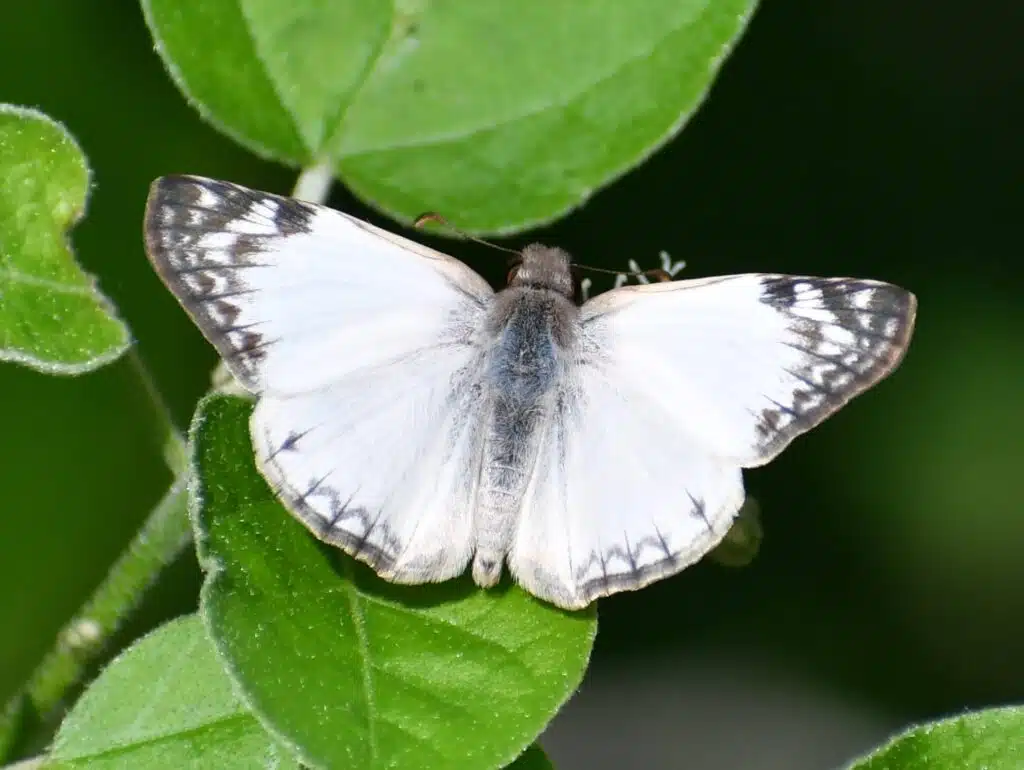
The Laviana White-Skipper (Heliopetes laviana) is a large butterfly. Its wingspan expands to 42mm.
Known as one of the largest species of black and white butterflies, the Laviana White-Skippers is mostly known for living in nests.
These butterflies use leaves as a nest where they escape cold weather and possible predation.
Most of these butterflies are found in brushy areas at various altitudes.
Laviana White-Skippers are highly common in Texas.
Most adult butterflies of this genus are seen feeding on the nectar of small flowers.
23. Northern White-Skipper
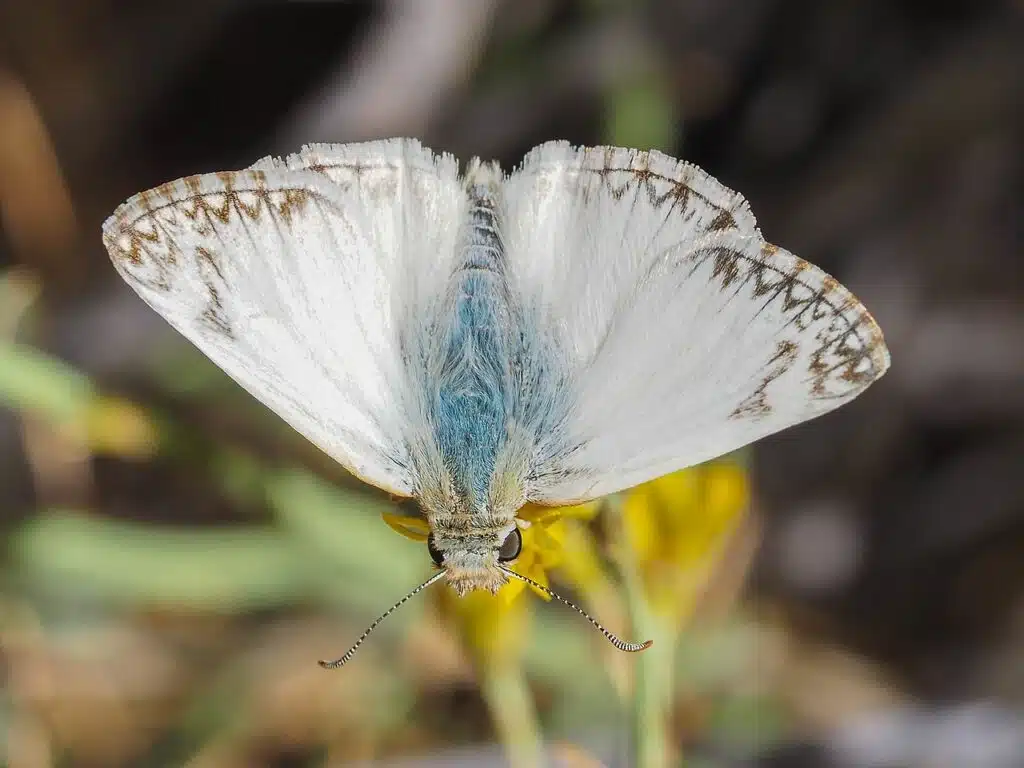
Northern White-Skipper butterflies (Heliopetes ericetorum) get their name from their numerous presence in Northwestern states.
However, these butterflies are seen all across the Western Coast where they are present down to Baja California.
Northwestern White-Skippers are mostly white. Females exhibit a few black dots on the margins of their wings, which are also present in males but which have a darker color.
Woodlands and dry terrains are among the favorite types of habitat for this species.
Northern White-Skippers feed on flower nectar with a wide preference towards mallows.
Like other butterflies, Northern White-Sippers use leaves to create rolled simple shelters which protect them from certain predators.
24. Rocky Mountain Parnassian
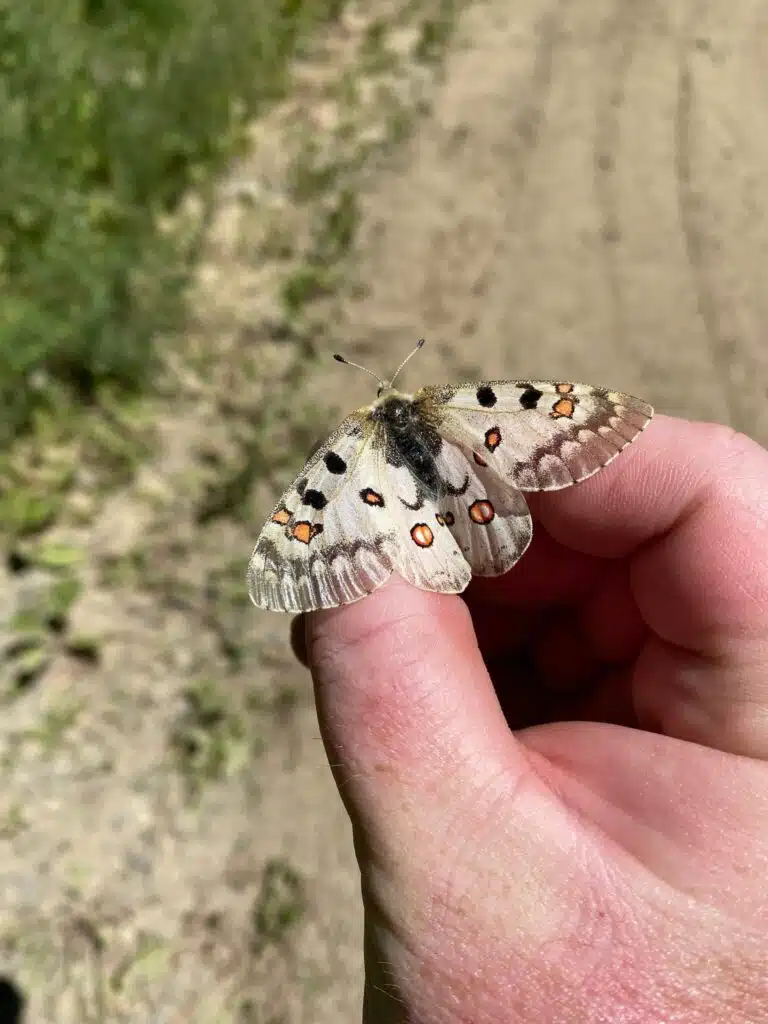
The Rocky Mountain Parnassian (Parnassius smintheus) is a butterfly species that comes in various colors.
A common morph of this species is white with a black mark. These butterflies have a wider range of morphs which even include a red color.
Butterflies of this genus are adapted to living at high altitudes. They are primarily found in The Rocky Mountains range. Furthermore, they have a widespread Canadian presence up to Alaska.
Butterflies of this genus have vivid coloring which means they attract plenty of predators.
Since males are brighter they tend to attract more predators or put themselves in a predation situation more often since they live in open sunny areas.
As a result, male Rocky Mountain Parnassians have bad taste compared to females.
25. Northern Azure
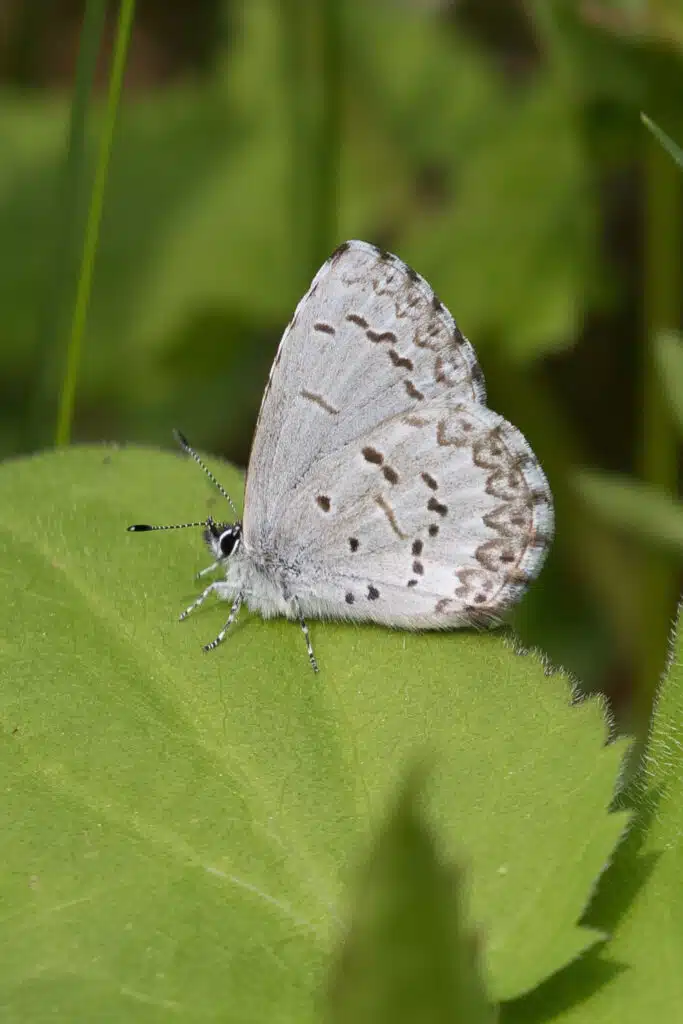
Northern Azures (Celastrina lucia) are among the few black and white butterflies native to Eastern North America.
Most similar species live in the West or the South.
However, the male Northern Azure isn’t white, as it has a light blue color. It’s the female Northern Azure that has a white color with black spots.
Small brown spots are also seen on the wings of the female.
Common around West Virginia, Northern Azure butterflies feed on nectar.
26. Sylvan Hairstreak
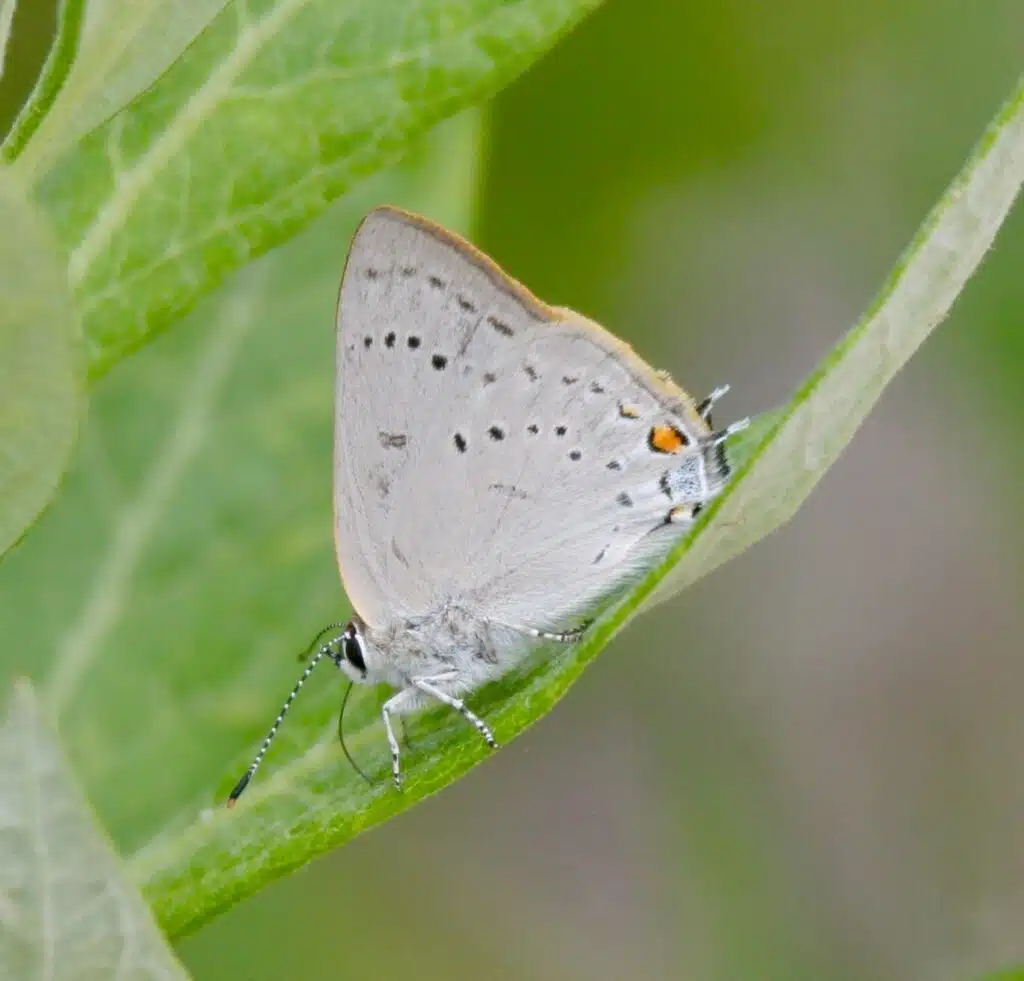
Sylvan Hairstreak butterflies (Satyrium sylvinus) are native to Western North America.
They have a gray dorsal wing color and a white ventral color. Both the dorsal and the ventral sides of the species have small black marks.
These butterflies are known to feed on hemp. They can also feed on the nectar of various other flowers.
Once the female Sylvan Hairstreak butterfly mates eggs are laid on trees. Willows and other trees next to water sources are preferred for laying eggs.
The eggs overwinter on trees with the first butterflies emerging in May.
27. Pine White
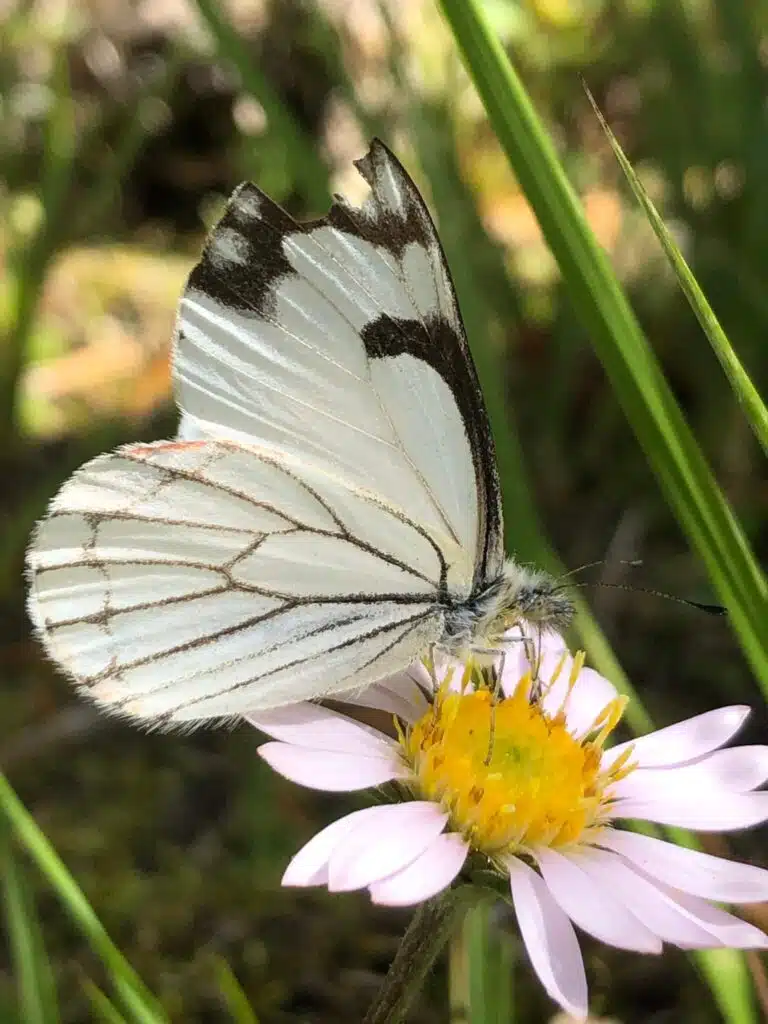
The Pine White butterfly (Neophasia menapia) is one of the largest black and white species in North America.
Pine Whites have a wingspan larger than 50mm and are found along the Western Coast states.
These butterflies have a widespread distribution in California.
Pine White butterflies get their names from their dominating white color.
They have visible black veins and visible black stripes which make for a contrasting color.
Nectar is the primary food source for adult Pine Whites. They feed on rabbitbrush nectar.
28. Desert Checkered-Skipper
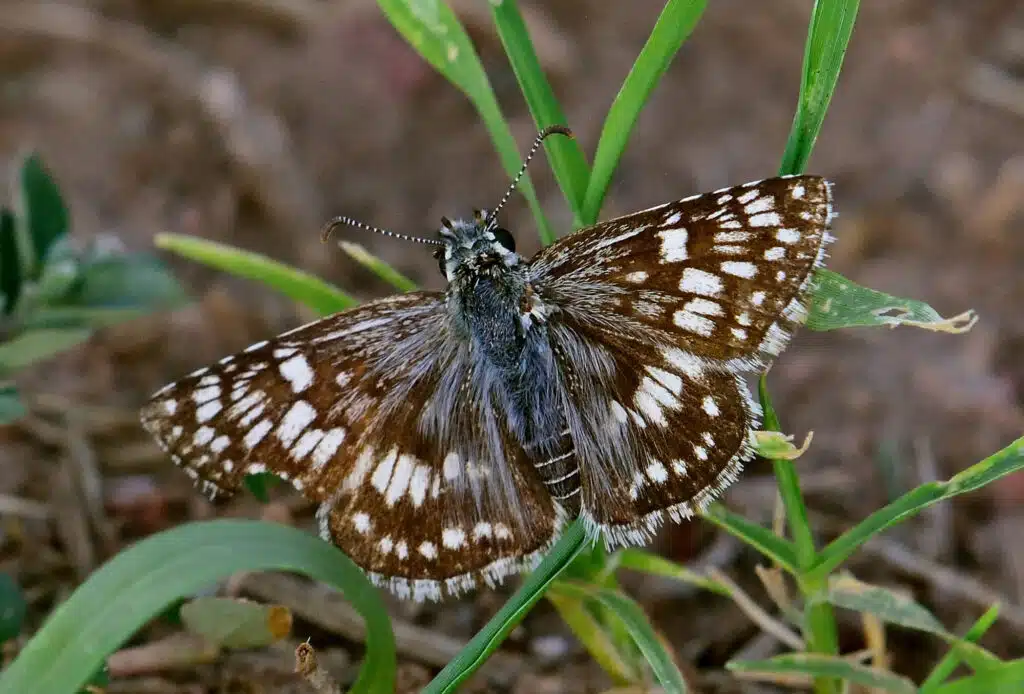
As the name implies, the Desert Checkered-Skipper (Burnsius philetas) is a common species in Texas and Arizona, especially in the dryer areas of these states.
Desert Checkered-Skippers are also highly common in Mexico, particularly on the Eastern Coast.
These butterflies have a bright white color with black dots and stripes. Their wings can appear transparent in direct sunlight.
Black is dominating on the wings of males, with just a few white spots. Females have white-dominant wings with black spots.
Feeding on flower nectar, butterflies of this species are frequently seen on mallow.
29. Western White
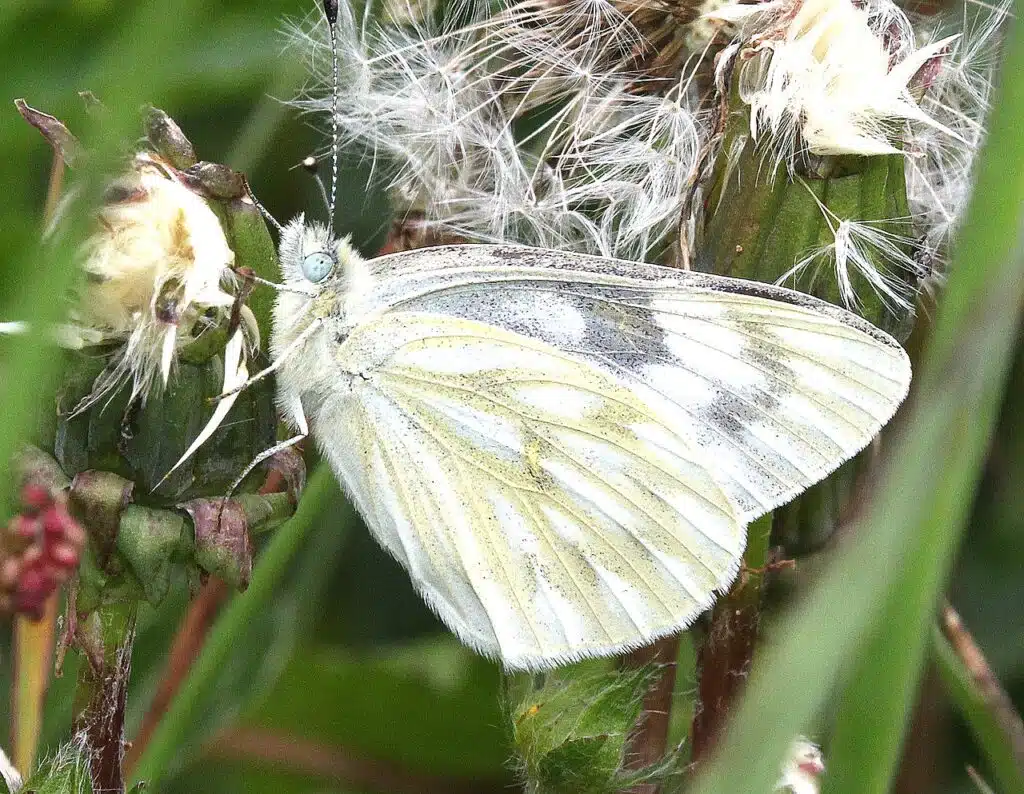
Western White butterflies (Pontia occidentalis) are common in Western North America.
They have a white dominating color with black, brown, and blue spots. The darker spots are seen on the edges of the wings while its blue coloring is seen closer to its body.
These butterflies have a large wingspan as they can grow to a maximum size of up to 53mm.
Western White butterflies have known pests of mustard and cabbages as adults.
Caterpillar Western Whites feed on entire flowers. They also consume fruit.
The introduction of predatory species is one of the common methods by which this species can be removed from crops.
30. Dotted Blue
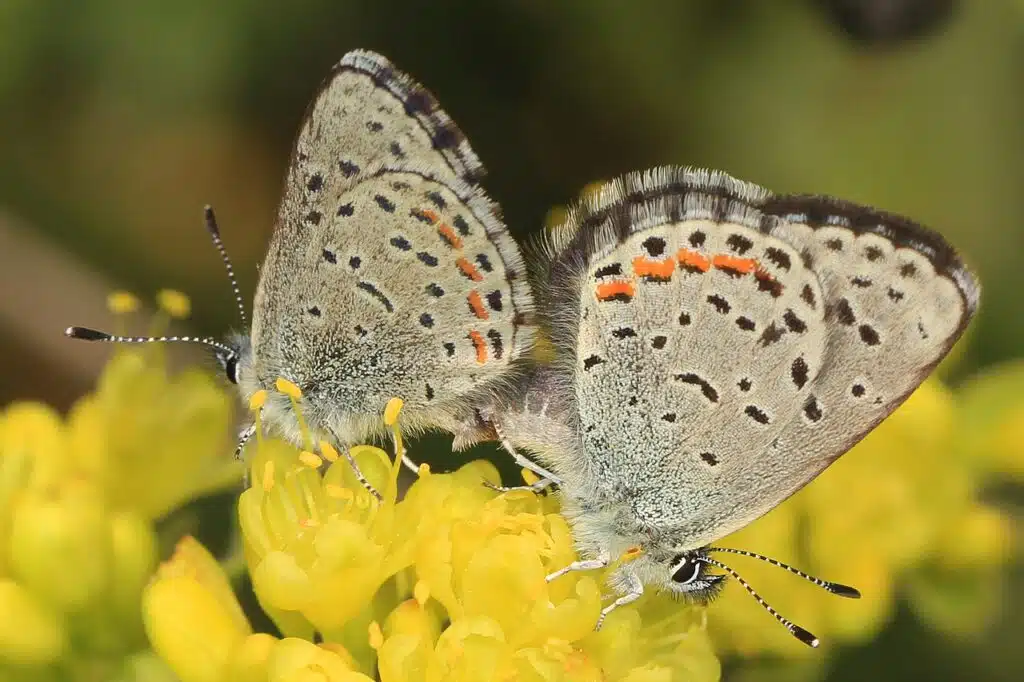
Feeding on Eriogonum nectar, Dotted Blue (Euphilotes enoptes) has a limited presence in North America.
This species is mostly present around the West Coast, particularly in California.
The species is known for its blue coloring. The underside of the male and the female is mostly white and black.
Off-white is specific to areas closer to the body. This butterfly also has small black dots around the wings and orange dots on the edges of the wings.
The scattered presence of these butterflies across the West Coast is believed to be influenced by urbanization.
Highly present on beaches and sandy terrains close to water, these butterflies face a diminishing natural habitat with urbanization.
31. Mustard White
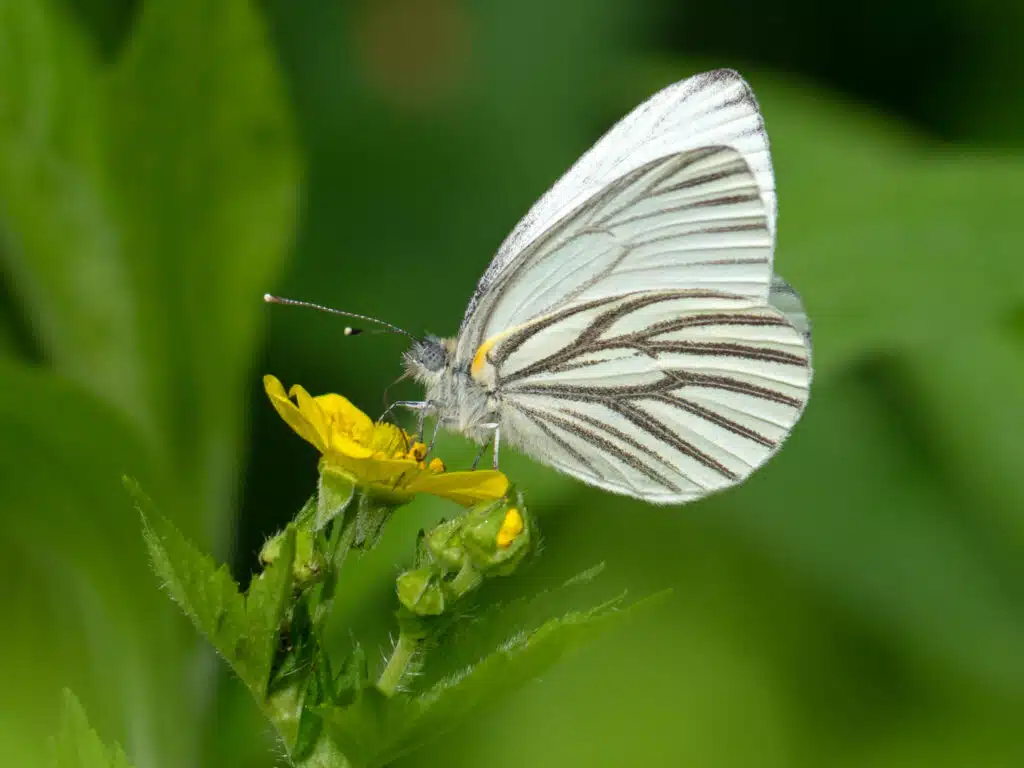
Mustard White butterflies (Pieris oleracea) have white wings with black stripes.
The stripes on the wings look like wide veins. Green or yellow coloring is also seen on the underside of the wings.
Mustard White butterflies feed on the nectar of various mustard plants. These aren’t mustard crops but toxic mustard plants they find in Eastern regions.
The species is common on prairies and next to woodlands. It adapts to new types of toxic mustard but its population across the continent is diminishing.
32. White-patched Skipper
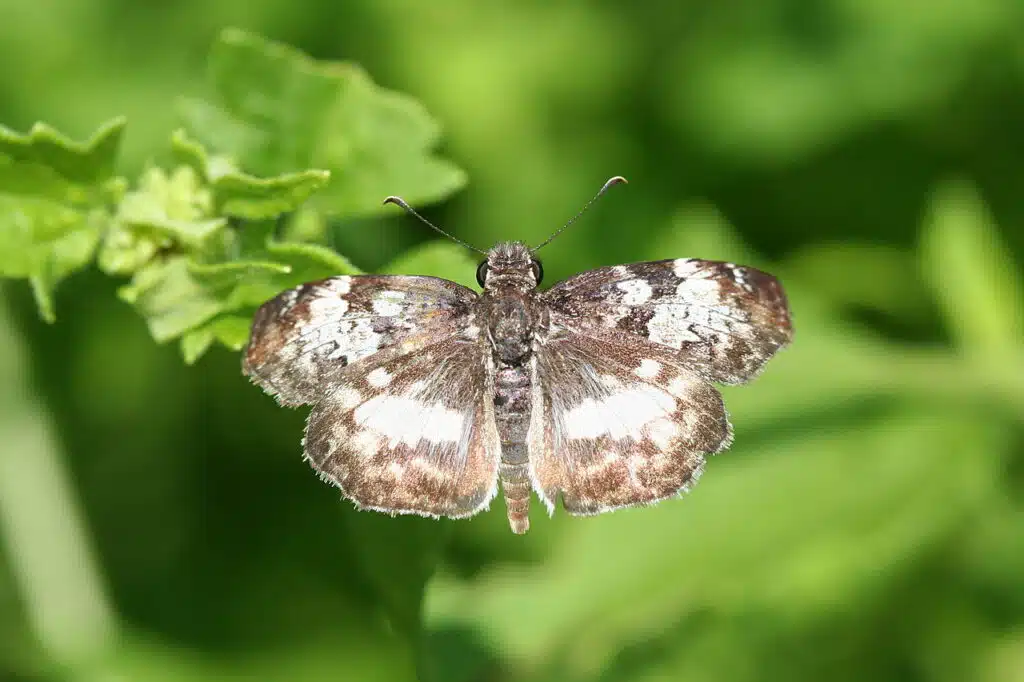
The White-patched Skipper (Chiomara georgina) is a tricolored species. It has black, brown, and white wings.
Its dominant colors are black and brown. White patches are seen on the wings of the species in various sizes.
The species has an extensive habitat in Central America with a limited presence in North America.
It can only be found in the Southern regions of California, Arizona, and Texas. Its widest populations live in the area of Phoenix and around San Antonio.
These butterflies love tropical woods and are seen in areas with shrubs such as the Barbados cherry, common in some Southern gardens.
33. Two-banded Checkered-Skipper
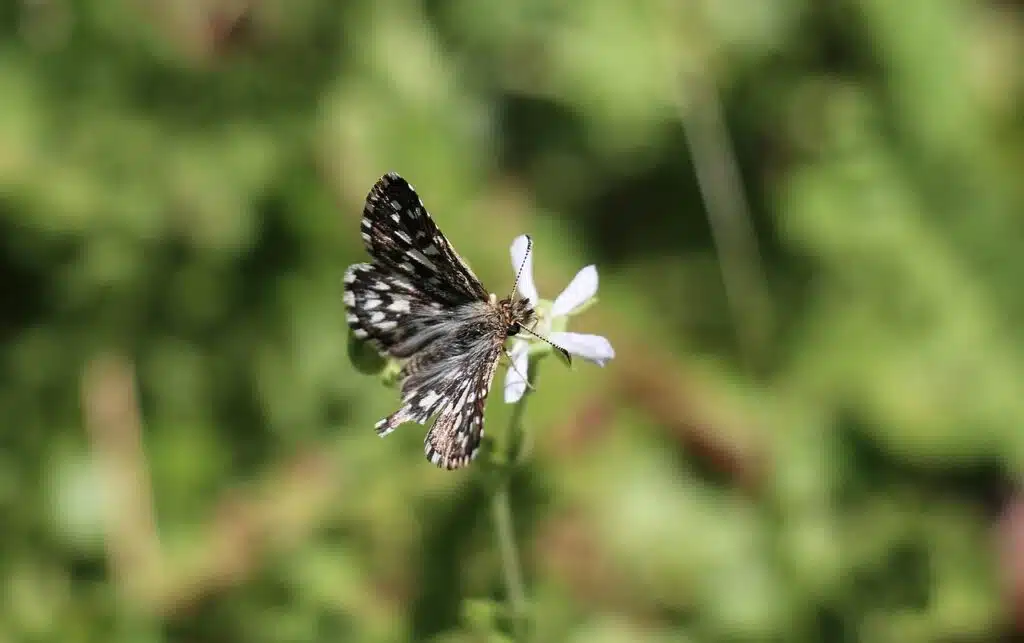
Commonly seen around The Rocky Mountains, the Two-banded Checkered-skipper (Pyrgus ruralis) is a species of brown butterfly with black and white marks.
Its dominant color is brown in the case of males. Black and white patches are common in this species.
Forest clearings and meadows in the valleys are among the preferred habitats for this species.
Many know the Two-banded Checkered-Skipper as a species that feeds on roses. It’s seen feeding on rose nectar at various altitudes.
While it has a preference for valleys, the Two-banded Checkered-Skipper can live at a high elevation of up to 10.000 feet.
34. Spring White
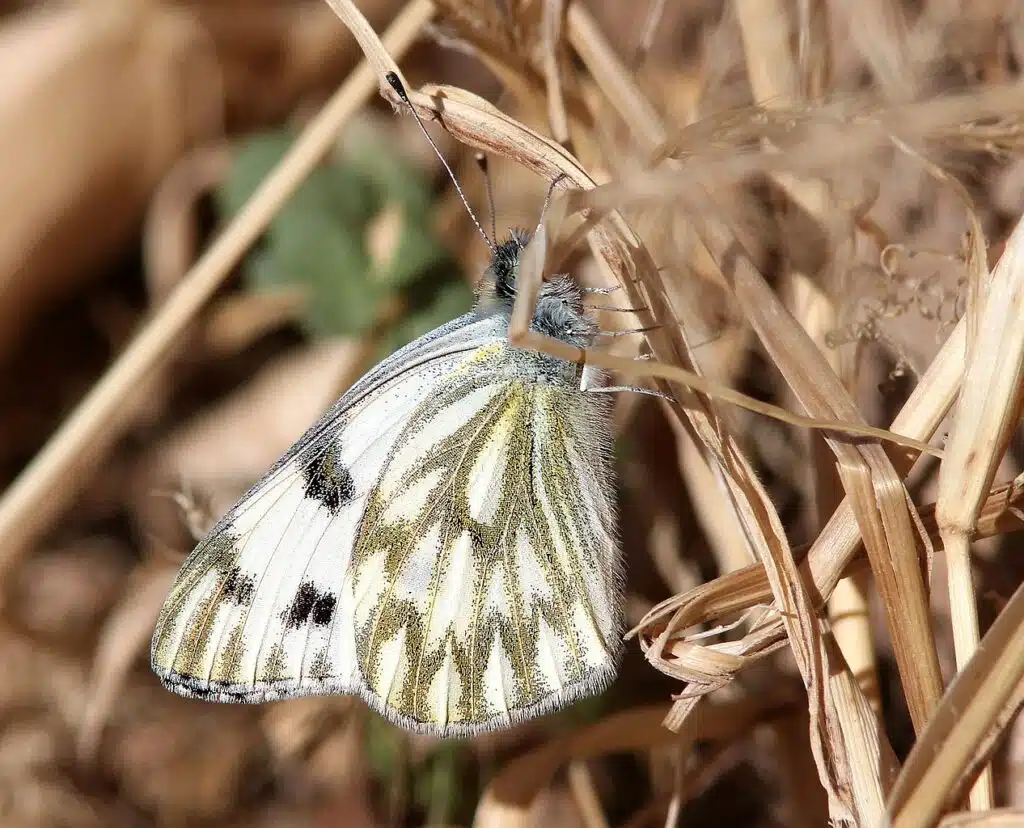
Common on dry slopes, deserts, and other dry climates, the Spring White (Pontia sisymbrii) is a species of almost completely white butterflies.
This genus has just a few black dorsal spots and black ventral vein-like stripes.
Both males and females have the same base white color.
The larvae of the Spring White feed on the leaves of flowers.
Adults feed on the flower buds themselves. Many flowers in the mustard family represent the main nectar source for adult Spring Whites.
This species is known to inhabit almost the entire region of Western North America with widespread distribution from Canada to Mexico.
35. Ancilla Blue
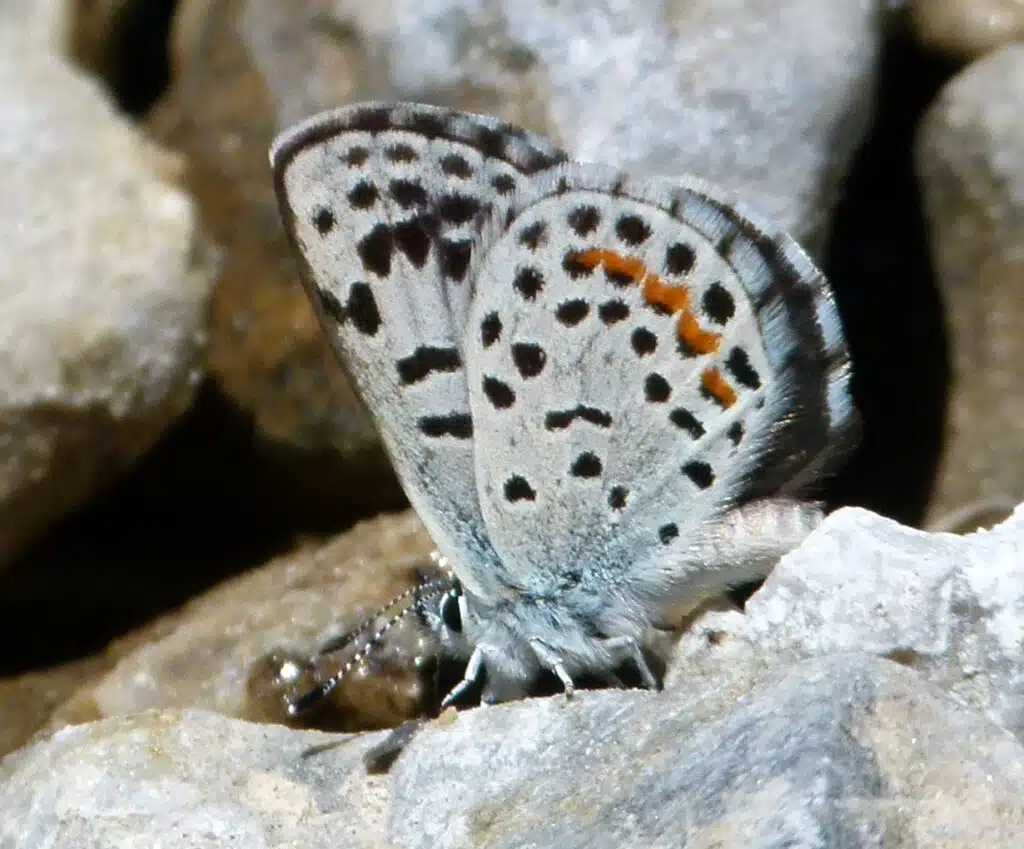
Ancilla Blue (Euphilotes ancilla) is a species with white wings and black dots. It also shows orange stripes on its wings.
White is a dominant color on the wings and it’s often turned into a gradient and a final off-white color towards the rear wings.
The black spots on the wings are small.
Butterflies of the species live in an area known for having many species due to a combination of mountains, valleys, and sun exposure in Western North America.
This species lives on exposed slopes which get plenty of sun.
It feeds directly with plant nectar but the plants it feeds on are very specific to the wild buckwheat family.
This group of plants also includes California buckwheat.
36. Turk’s-cap White-Skipper
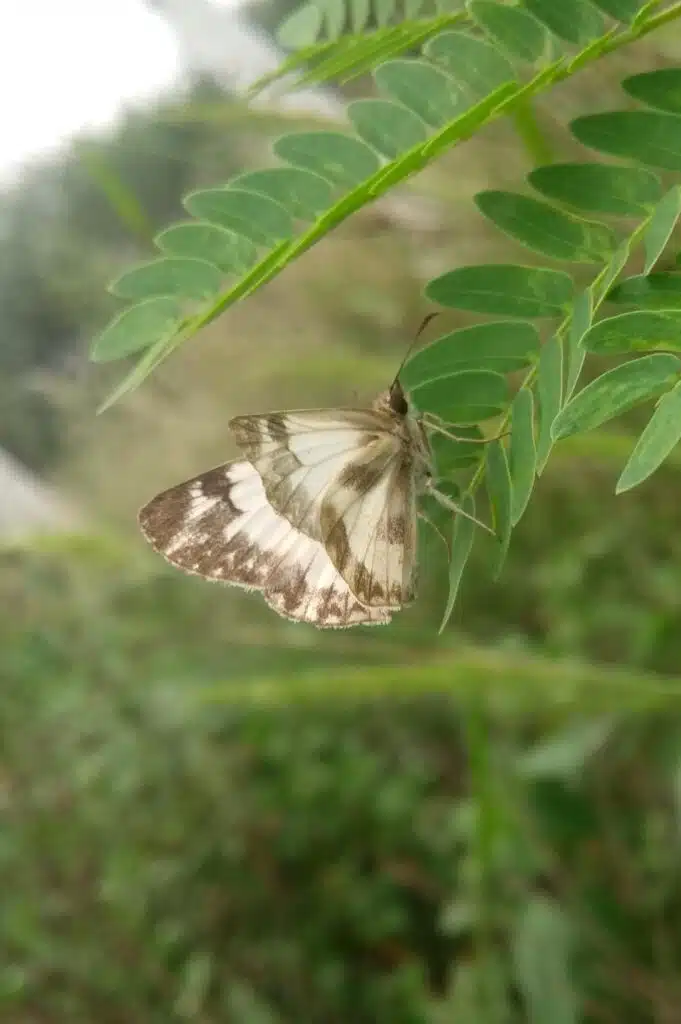
This species (Heliopetes macaira) lives in subtropical forest edges.
It has a very limited presence in the US, mainly in Southern Texas around Austin, San Antonio, Houston, and Corpus Christi.
The species is known for having contrasting black and white wings.
White is the dominant color of the butterfly with black or dark gray wing edges.
The species have a wingspan of just over 1 inch and it feeds on flower nectar.
It prefers flowers in the mallow family.
Turk’s-cap White-skipper caterpillars have a different diet. They feed on flower nectar and fruits.
The caterpillars of this species are almost never seen as it tends to shy away in flower stems.
37. Arrowhead Blue
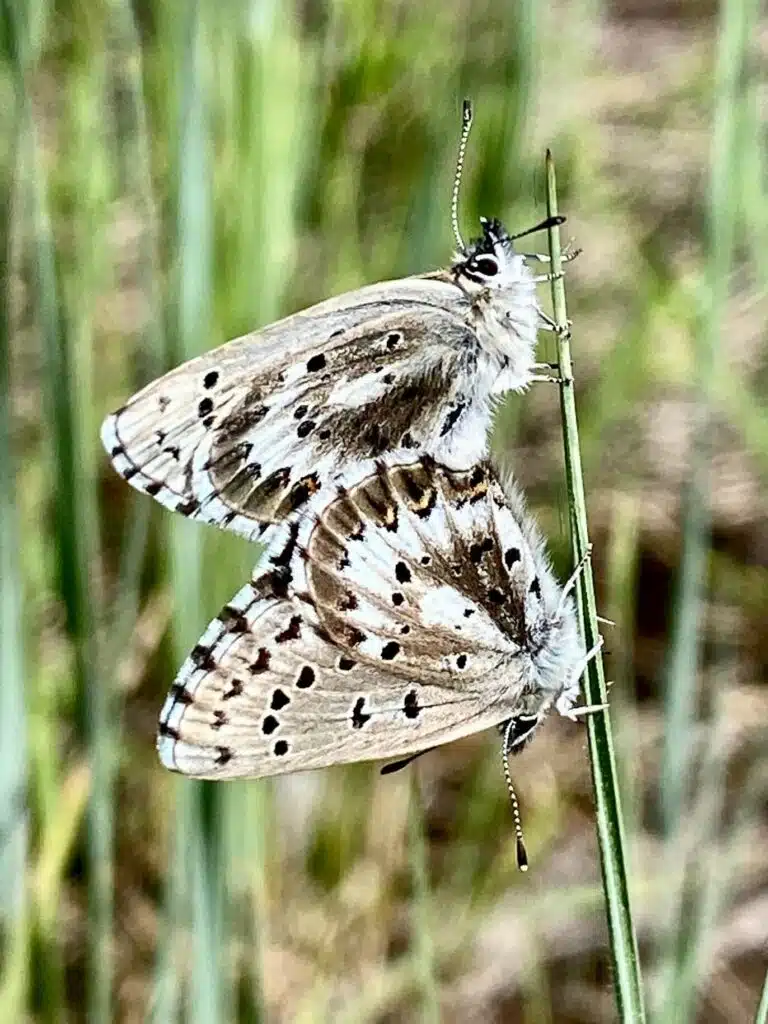
Arrowhead Blue butterflies (Glaucopsyche piasus) are common in North American territories with lupines.
These butterflies have white color wings with black stripes and black dots.
Adults only feed on the nectar of lupine flowers while the caterpillar of the species also feeds on flowers of the pea family.
The wingspan of the Arrowhead Blue is slightly larger than the wingspan of the Turk’s-cap White-Skipper.
However, it’s only the underside of the Arrowhead Blue that’s white and black as the dorsal coloring is white, blue, and black.
38. Gray Copper
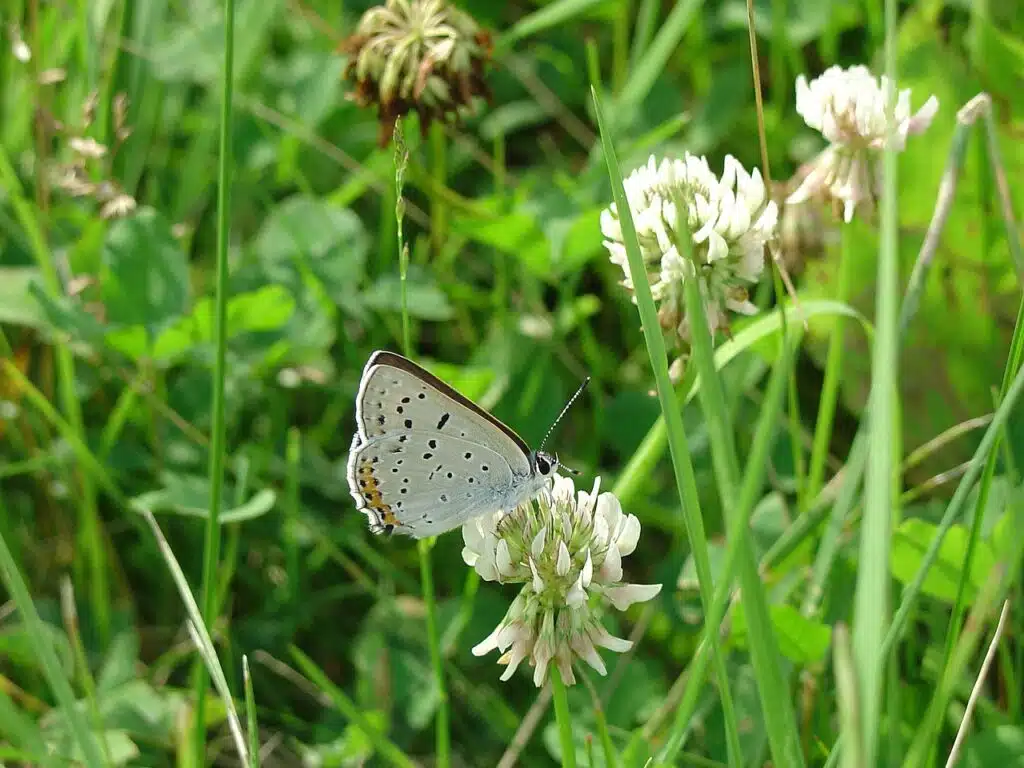
Gray Coppers (Tharsalea dione) have white wings, black dots, and orange stripes or orange marginal bands.
The wingspan of the species measures just over 1 inch.
The ventral coloring of the wings resembles the dorsal coloring. A gray-white color with black dots is also seen on the ventral.
Butterflies of this species live in open areas and ditches at the base of foothills.
They can be seen in valleys since May.
Adult Gray Coppers feed on flower nectar and multiply in one brood per season until July.
39. Acadian Hairstreak
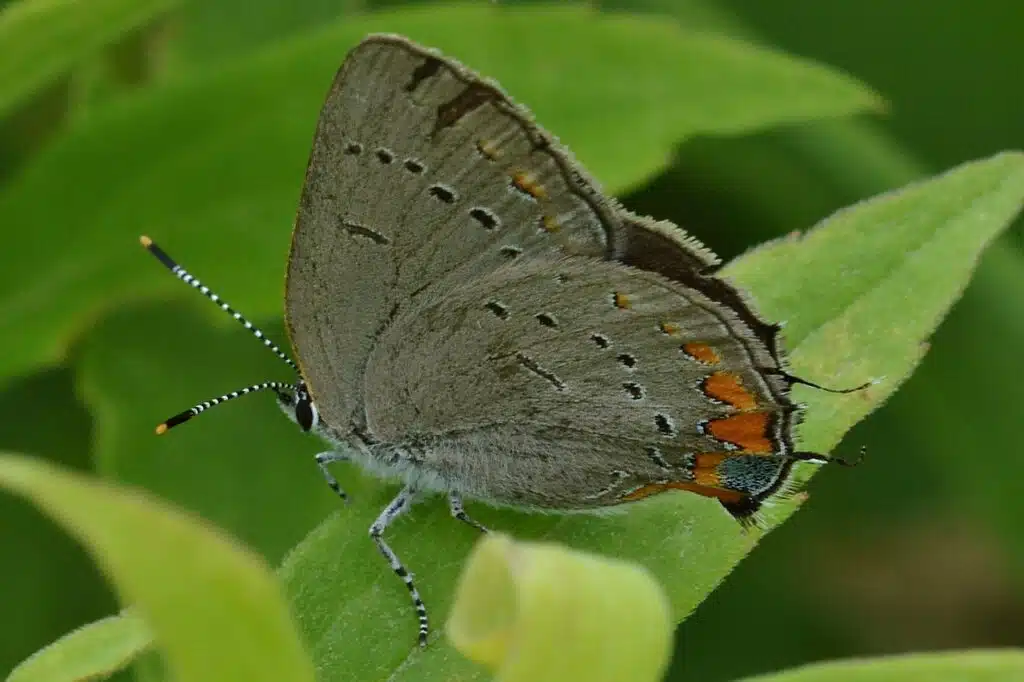
The Acadian Hairstreak butterfly (Satyrium acadica) has black and white ventral wing coloring.
Its dorsal is brown while the ventral wings are white, black, with orange bands.
These butterflies live in Northern US territories, including those in the East up to Maine.
They live and feed on willows. The black willow is one of the main host trees of the Acadian Hairstreak.
As a result, these butterflies are common along streams, rivers, and other water sources where willows grow tall.
The species appears late in the season with the first Acadian Hairstreak sights reported in June.,
Its flight season is short as the last butterflies are seen towards the end of August.
40. Desert Marble
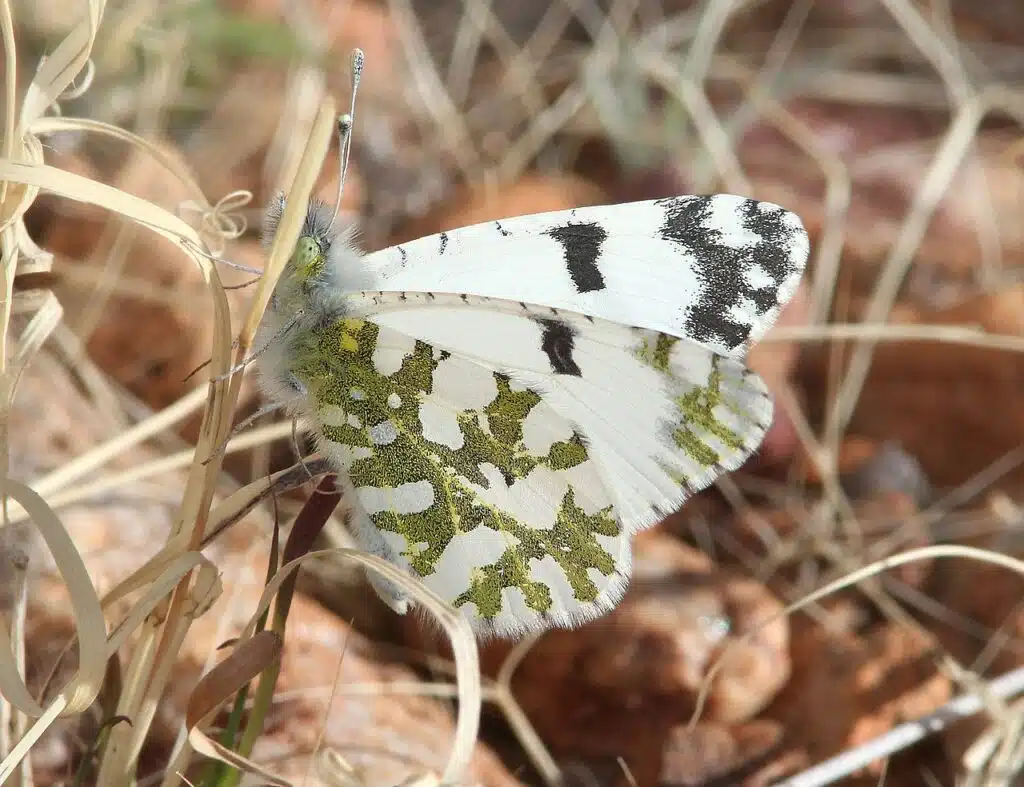
Desert Marble butterflies (Euchloe lotta) have a base white color. They have black stripes on the hindwings.
Gray stripes are also visible on the butterfly.
Desert Marbles have large wings, being some of the largest black and white species in the US.
They have a wingspan of at least 38mm with some of the larger individuals measuring up to 40mm.
As their name implies, they like living in arid habitats. They are found in deserts, dry slopes, and juniper woodland.
Desert Marble butterflies are some of the most commonly white and black butterflies in canyons.
Adults feed on pink and violet flowers, most in the group of phloxes.
41. Glaucon Blue
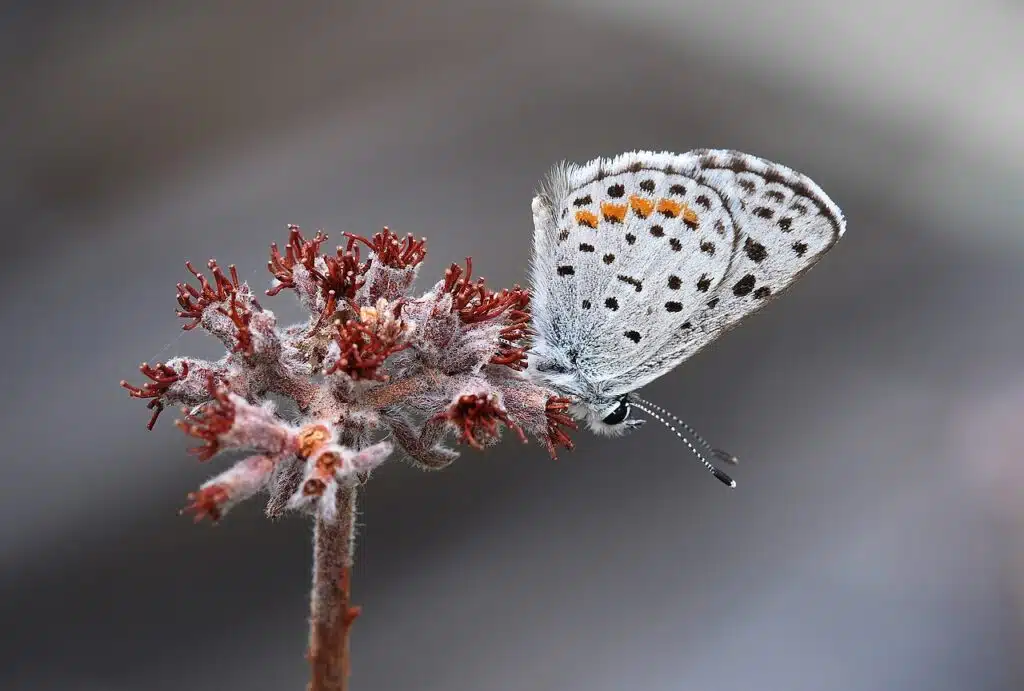
Common on Western pastures, the Glaucon Blue butterfly (Euphilotes glaucon) is one of the main black and white species found in the US.
This butterfly has irregular black patterns with marks and black spots.
It prefers well-drained soils and habitats such as pastures and high-altitude terrains that are almost dry.
The butterfly has a scattered presence in the West since it feeds on a single flower.
Glaucon Blue butterflies feed on Sulfur-flower buckwheat.
This is a type of bright yellow flower that tends to attract a large range of pollinators.
42. Small Checkered-Skipper
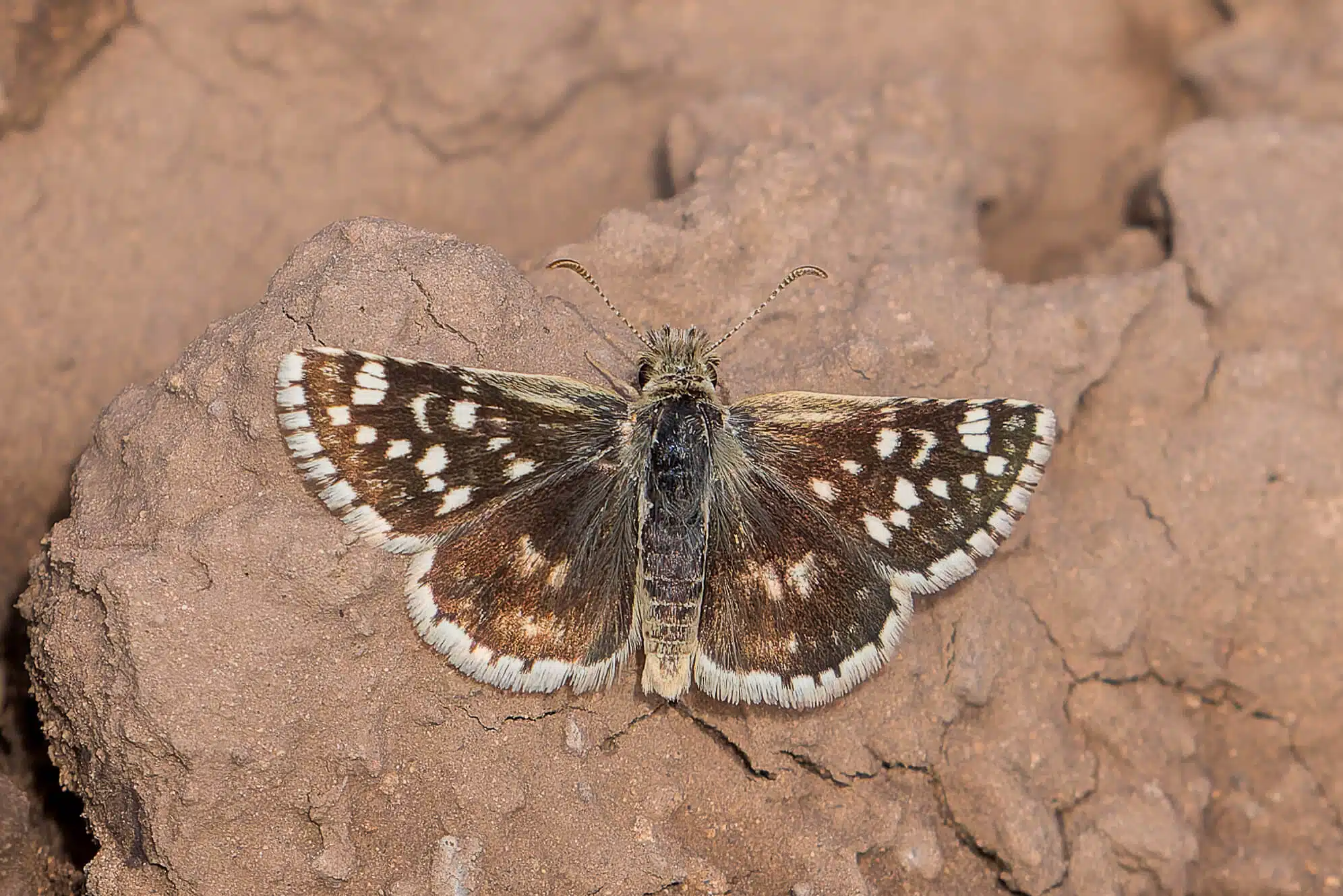
Small Checkered-Skippers (Pyrgus scriptura) have a brown-black body with white marks and stripes.
These butterflies have a wingspan of up to 1 inch.
They live in the Western part of the US and feed on flower nectar.
Mallow and globemallow are among the flowers they are mostly interested in feeding on.
You can find these butterflies in prairies and open land but not in woodlands.
43. Guatemalan Cracker
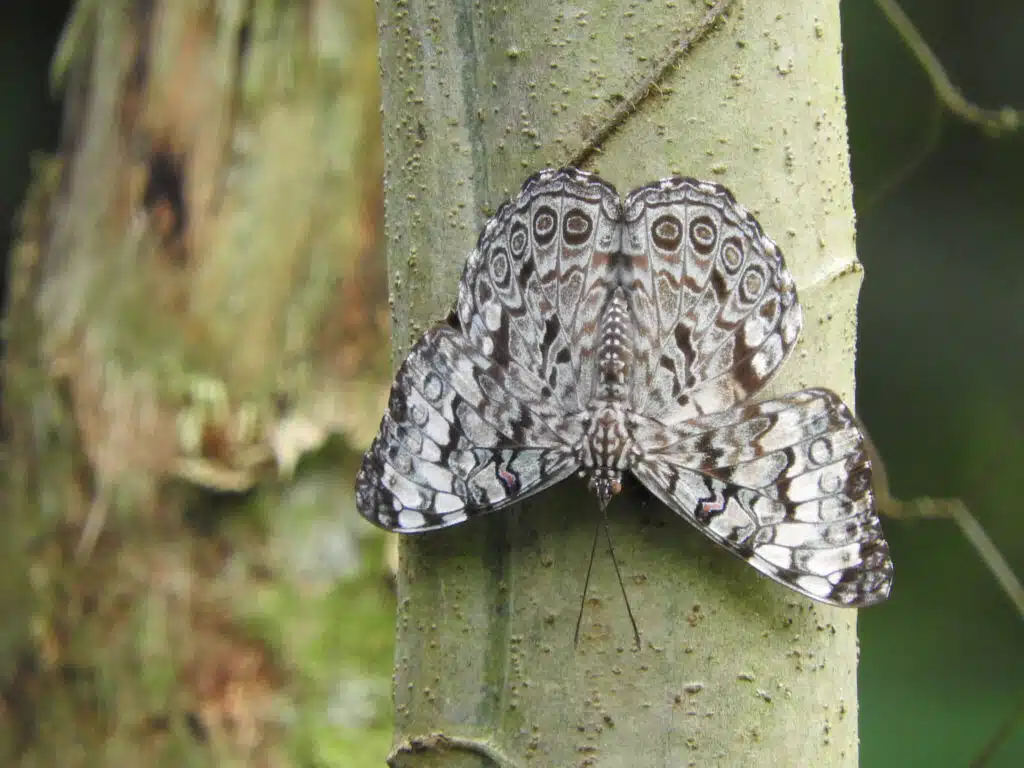
Most common in Central America, the Guatemalan Cracker (Hamadryas guatemalena) is one of the species that’s also highly common in Southern Texas.
This species has brown and white dorsal coloring and black and white ventral coloring.
Butterflies of this genus are known for their immersive behavior which means they make the most out of each food source they can find.
This is why the Guatemalan Cracker is one of the butterflies with a very broad diet.
It even feeds on dung alongside nectar and fruit.
44. Pallid Blue
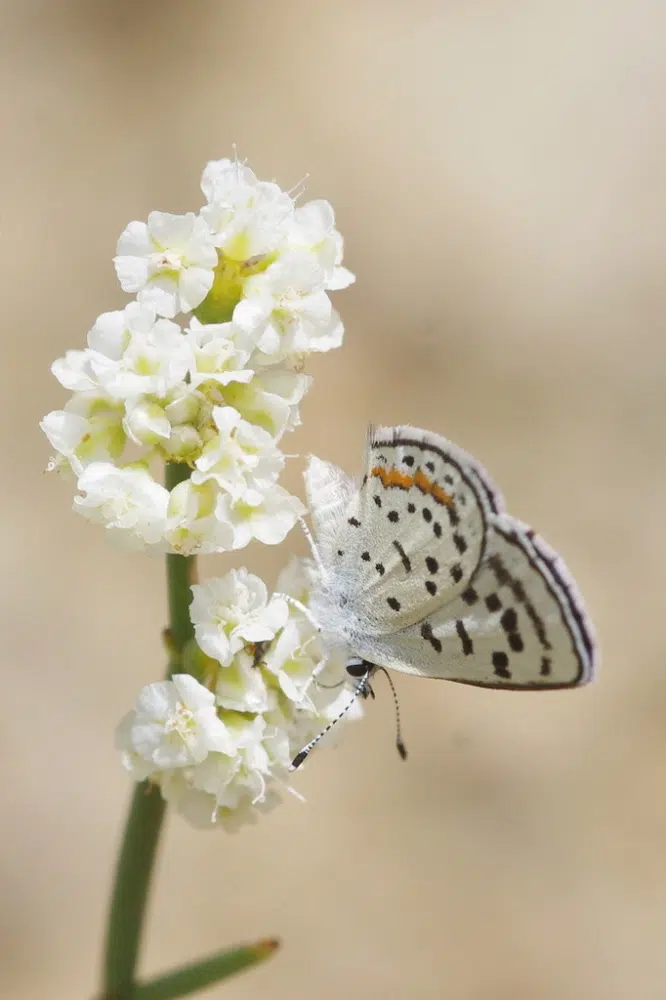
Pallid Blue butterflies (Euphilotes pallescens) have a bright blue to white color with black spots and black stripes.
These butterflies can also be brown dorsally and almost white ventrally.
They feed on various flowers for their nectar.
The biggest issue with Pallid Blue butterflies is their diminishing numbers with a risk of extinction.
While wild buckwheat is still highly present in North America for the butterflies to feed on, the sights of the species are starting to become rarer.
45. Chiricahua White
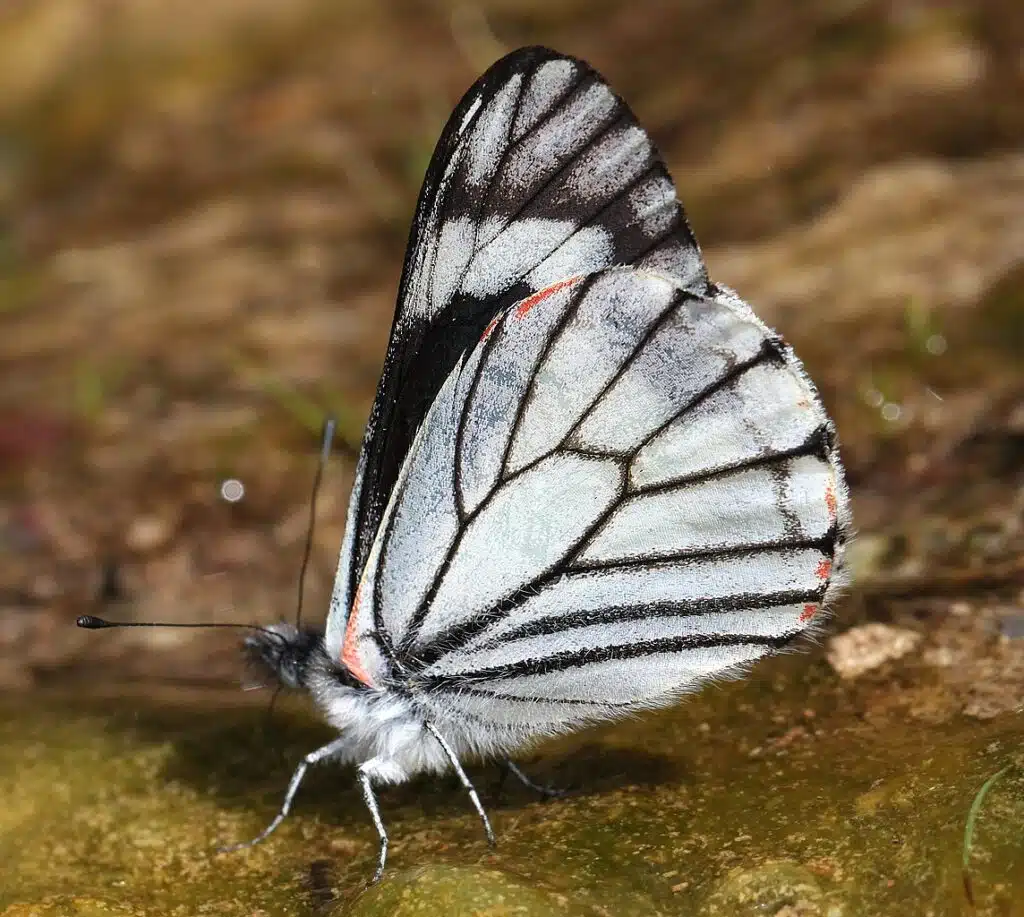
Chiricahua White butterflies (Neophasia terlooii) have a very different appearance when it comes to comparing males and females.
The female is dark orange and black while the male is white and black.
Female Chiricahua White butterflies are some of the largest species in North America with a wingspan measuring more than 2 inches.
These butterflies are only found in Southern Arizona and remote areas of Southern New Mexico.
Chiricahua White butterfly caterpillars are always seen on Western Yellow pine.
46. Arctic White
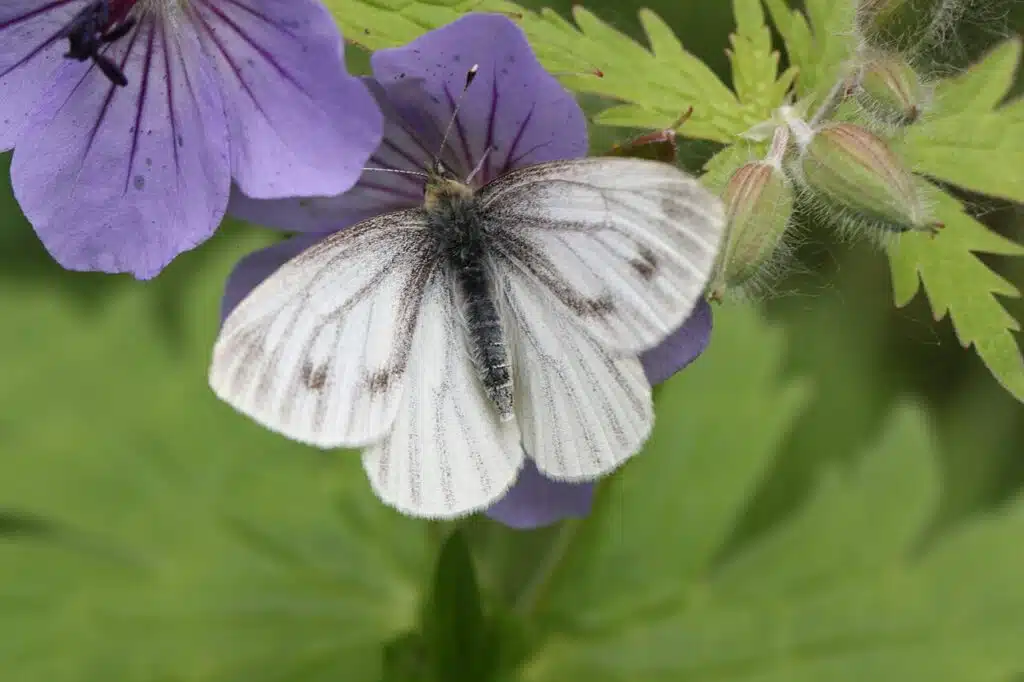
Arctic White butterflies (Pieris angelika) are one of the Northern black and white species.
The habitat of the species expands to Alaska. Arctic White butterflies are also found in Yukon Canadian territories.
The species has a white color with black stripes.
Females have a more nuanced appearance. They have a yellow body with black stripes.
47. Mojave Blue
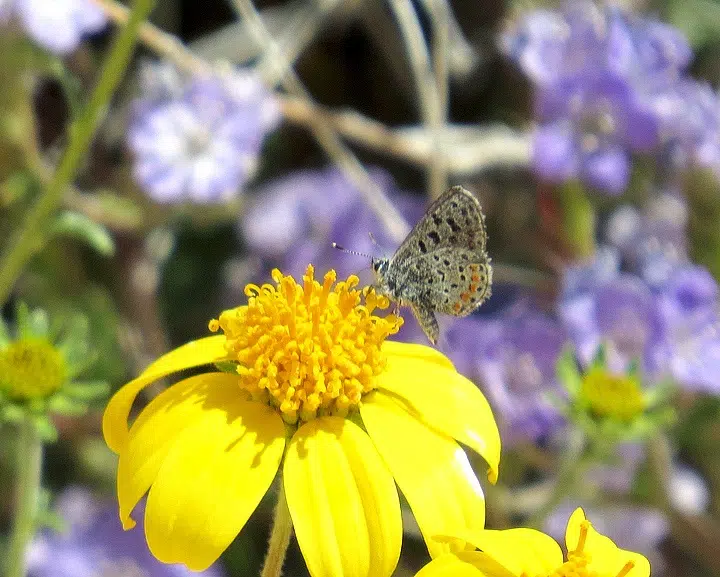
Mojave Blue butterflies (Euphilotes mojave) are a common species around the Mojave Desert.
These butterflies like arid climates and the vegetation around the Mojave Desert.
However, it faces an uncertain future due to the vegetation which is prone to fires such as cheatgrass.
These butterflies have white wings with black spots. They also show orange spots on the hindwings.
Mojave Blue caterpillars are known for only eating plants and fruit.
48. Sierra Nevada Parnassian
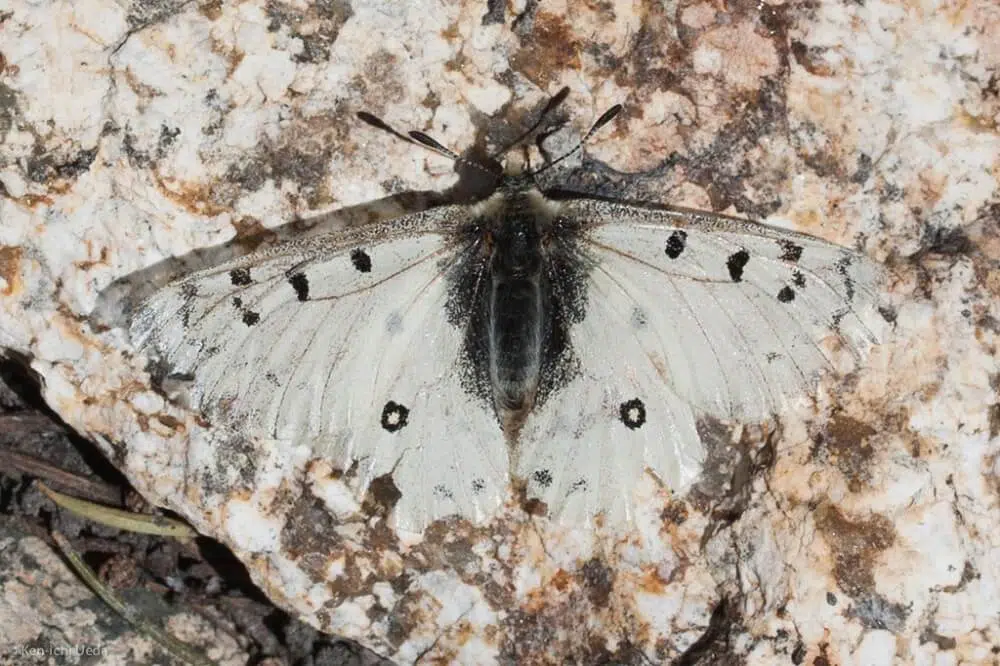
Sierra Nevada Parnassians (Parnassius behrii) are some of the rarest black and white butterflies in North America.
As the name of the species implies, these butterflies are only found in the Sierra Nevada region.
It’s where they feel most comfortable and females are even known for laying eggs almost anywhere, not only on flowers like other female butterflies.
This species has white wings that grow to a wingspan of more than 2 inches.
Sierra Nevada Parnassian butterflies have a white base color with brown stripes and 2 orange spots on the hindwings.
The species has a stable population in the Sierra Nevada region and California.
Butterflies of this genus have a long flight season. They can be seen in the Sierra Nevada region up to late September.
Further Reading: